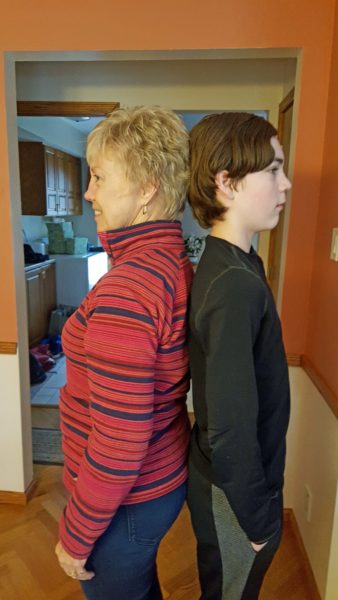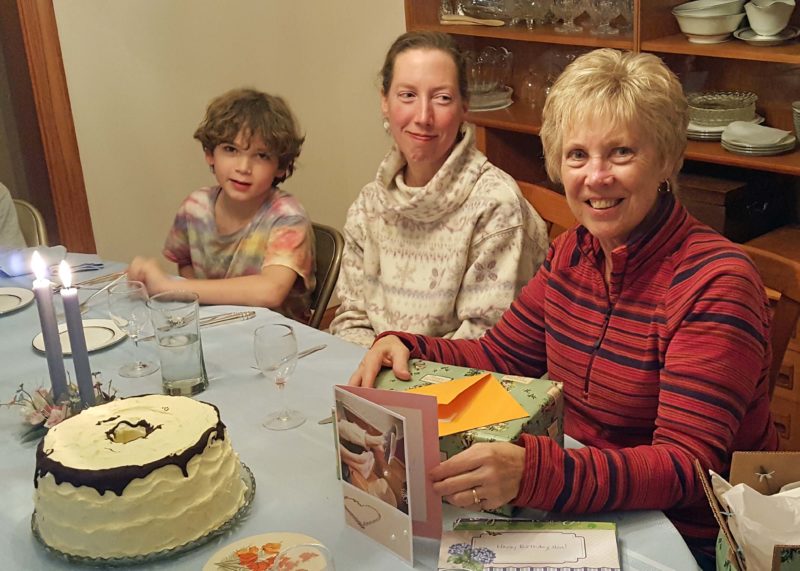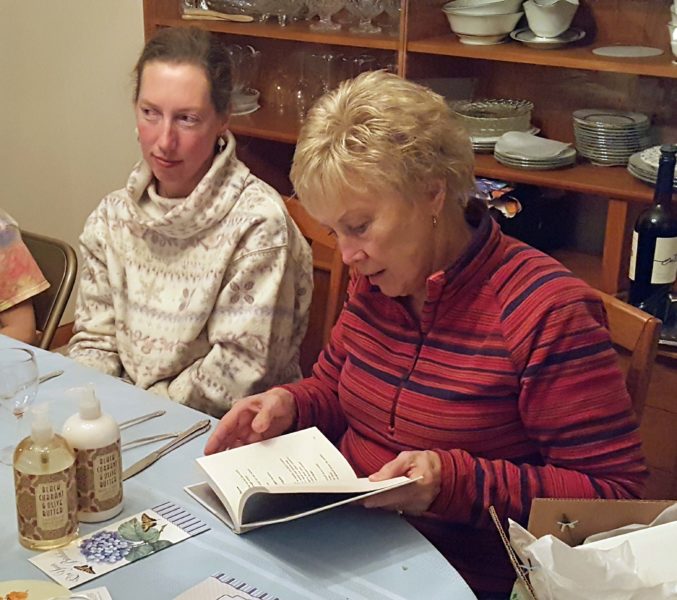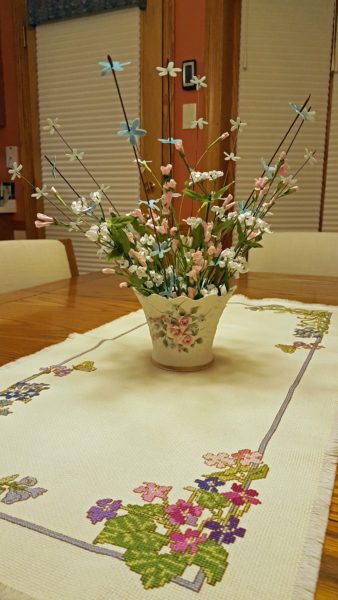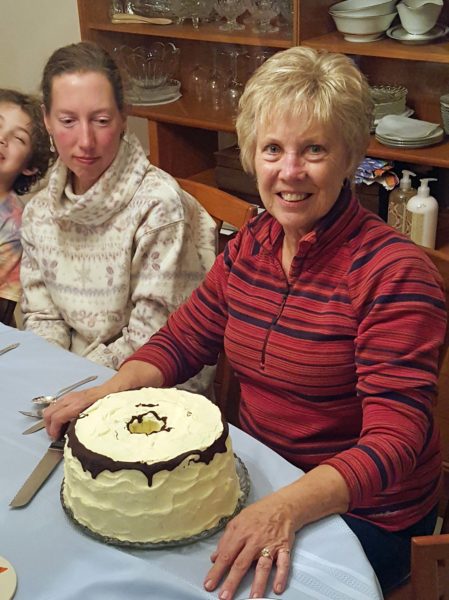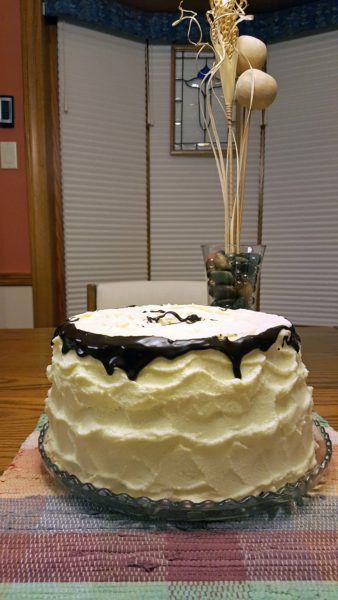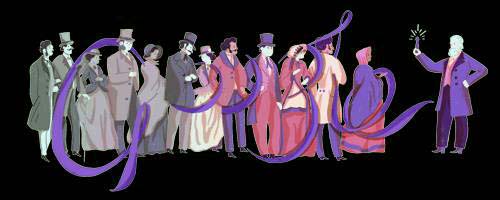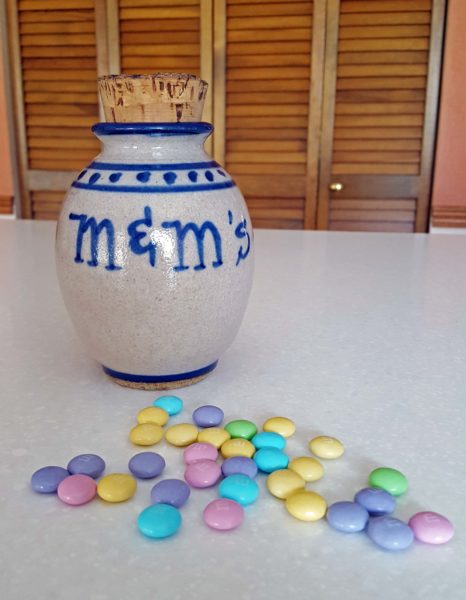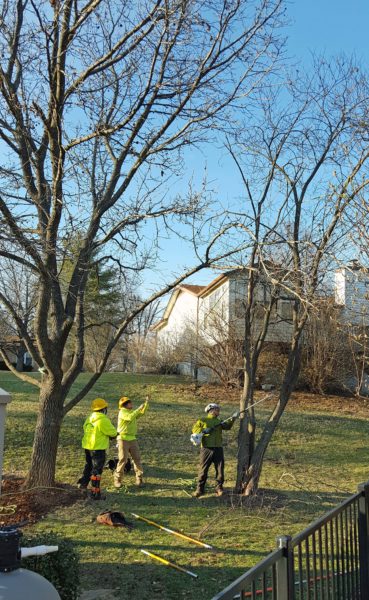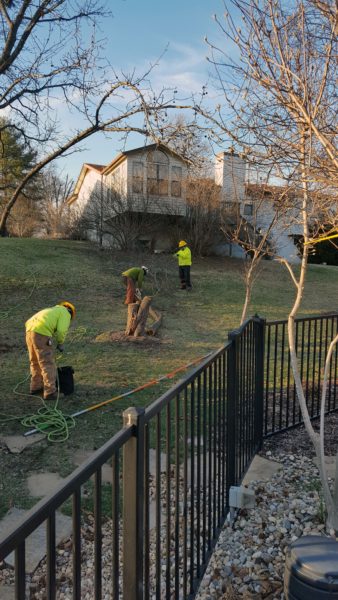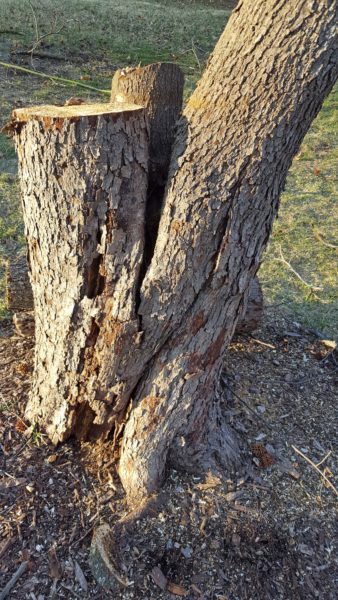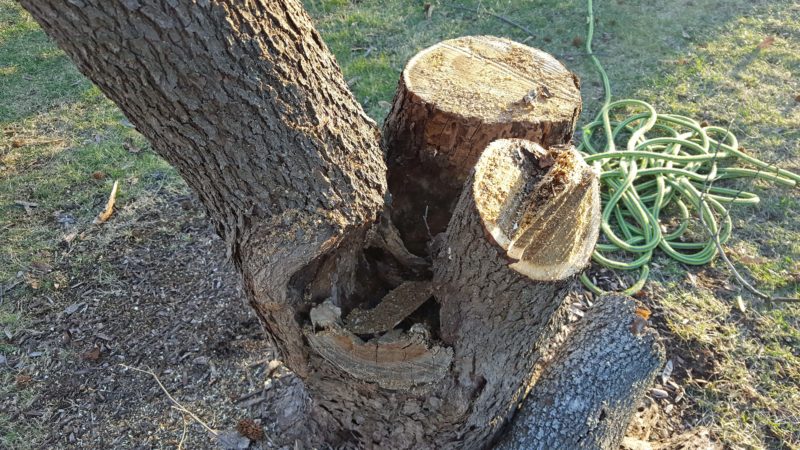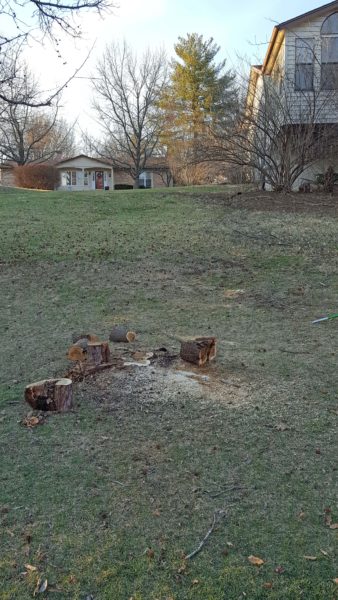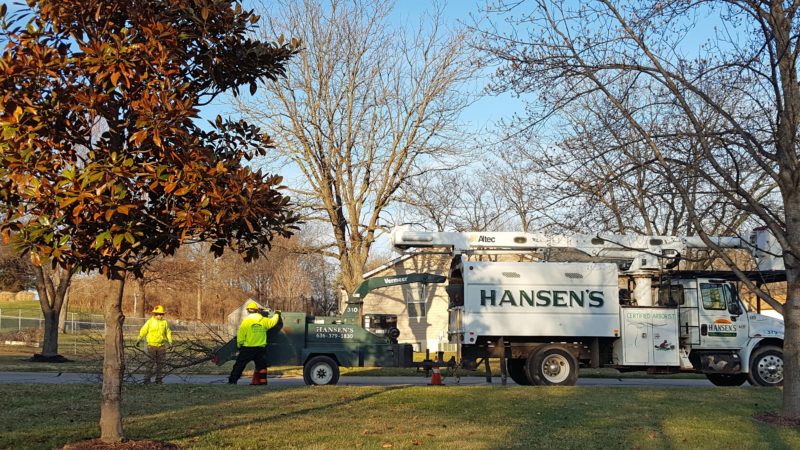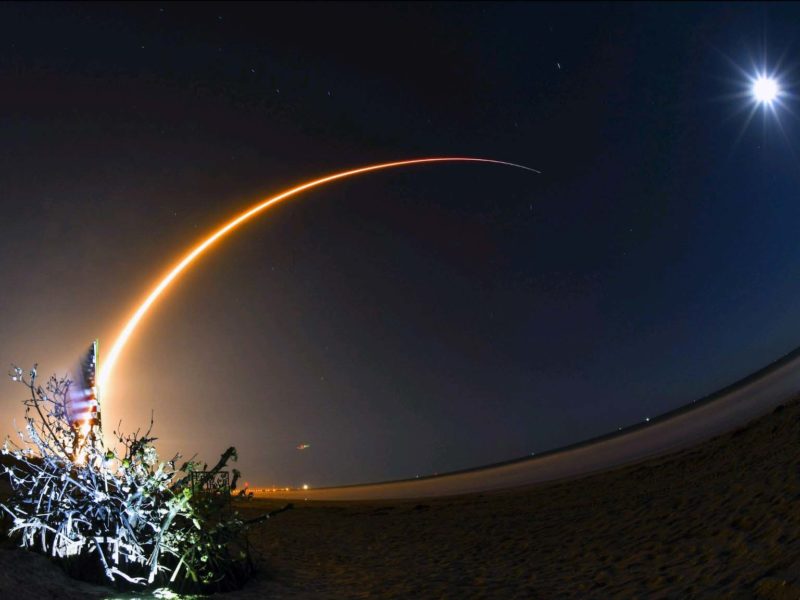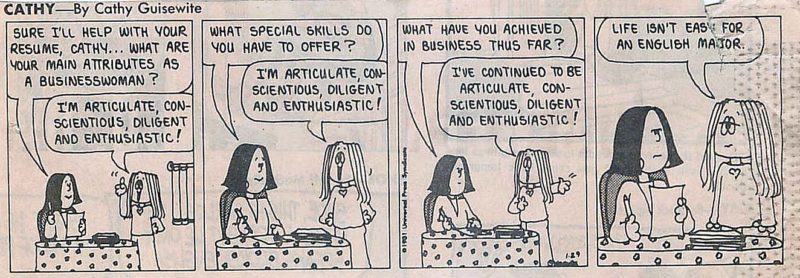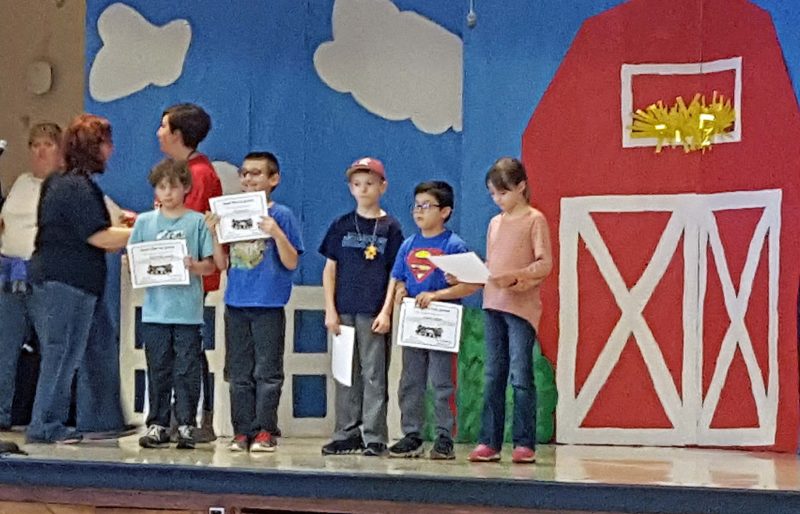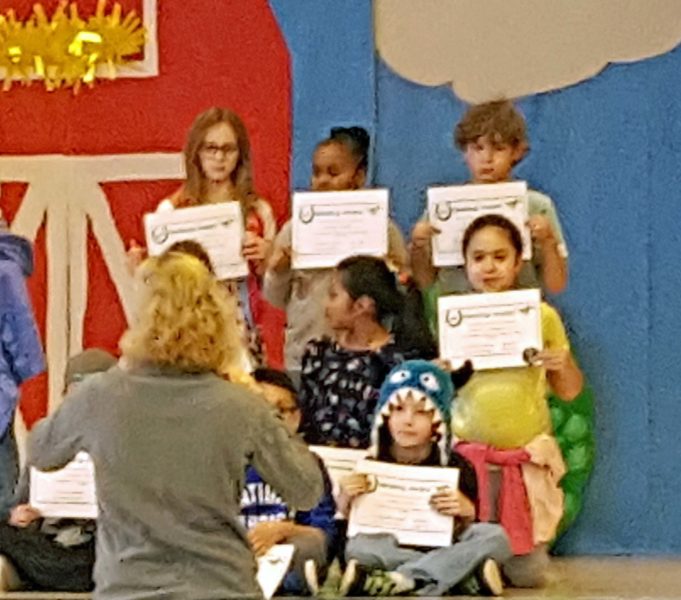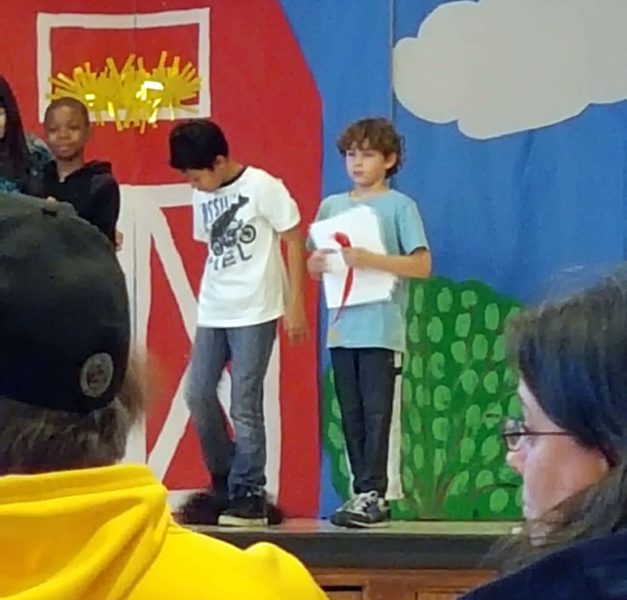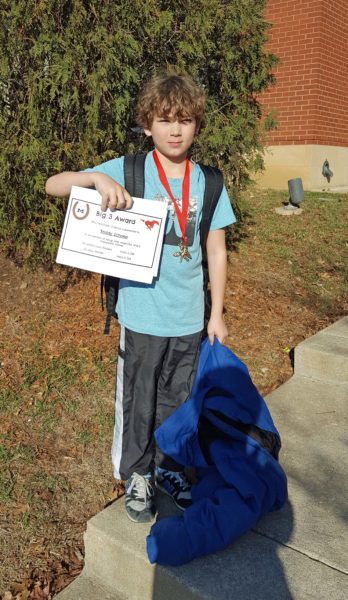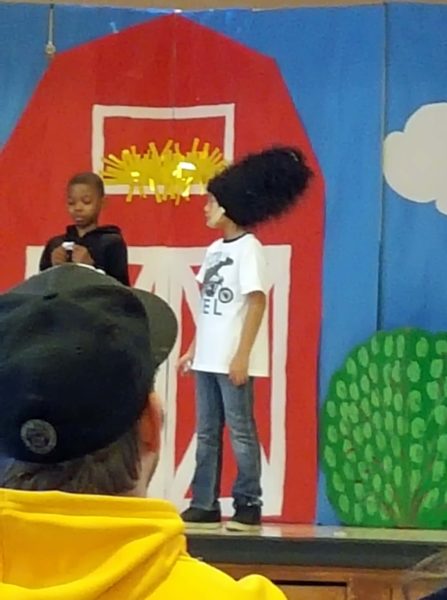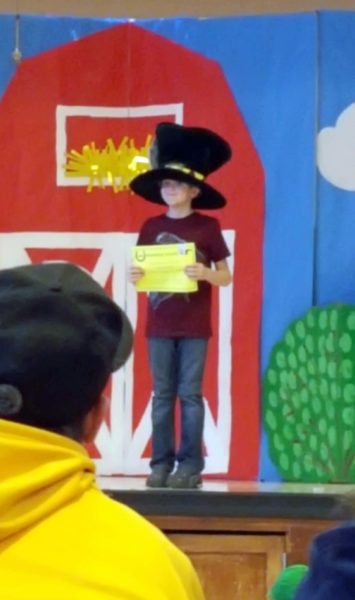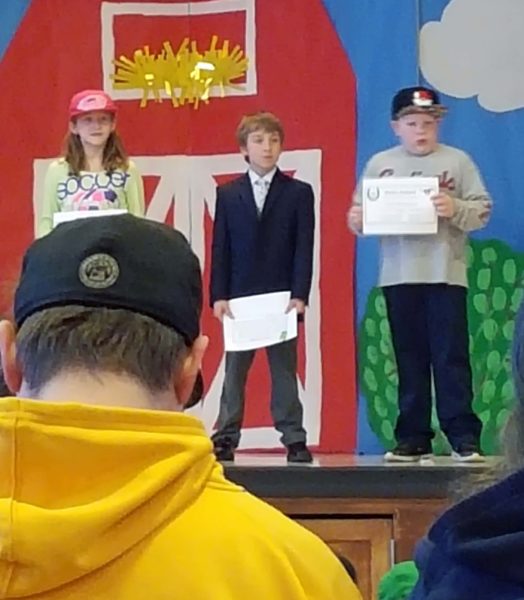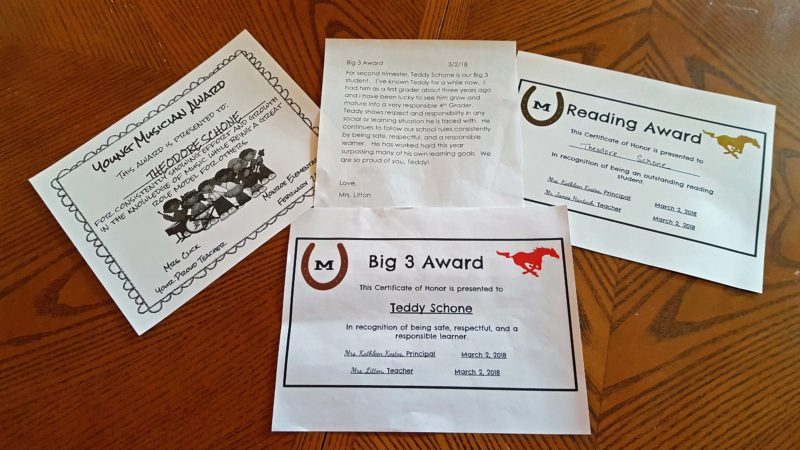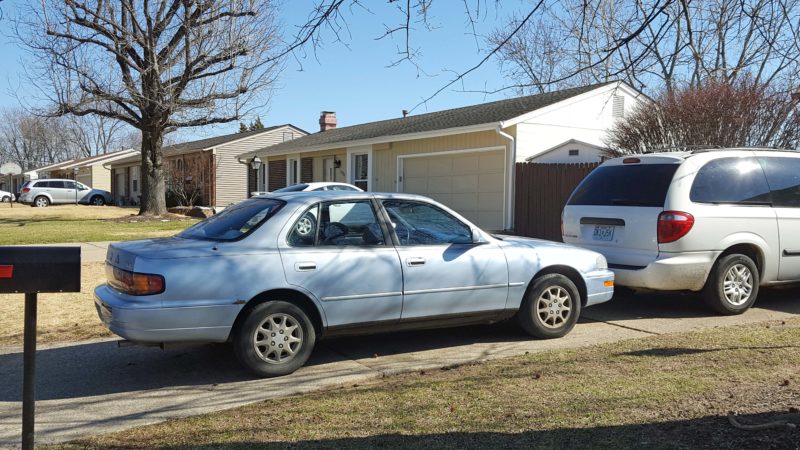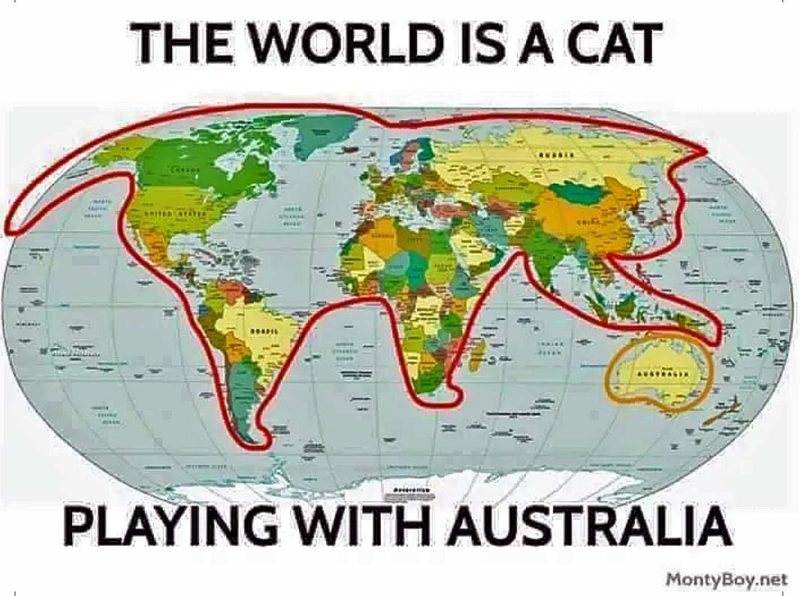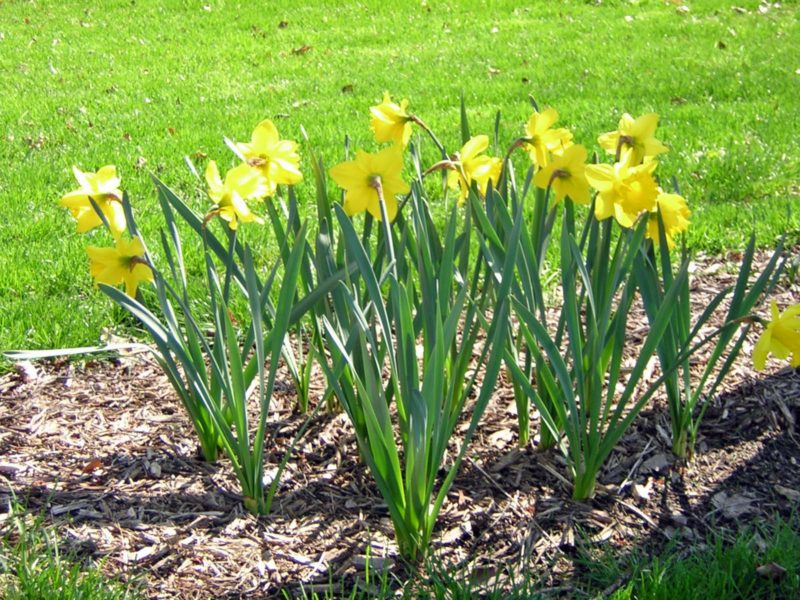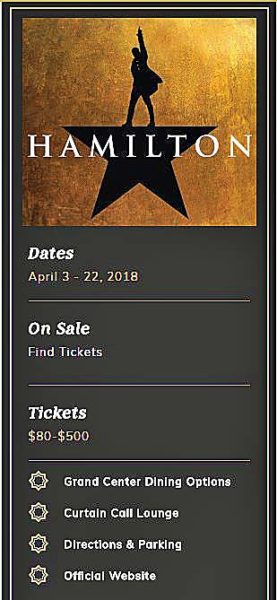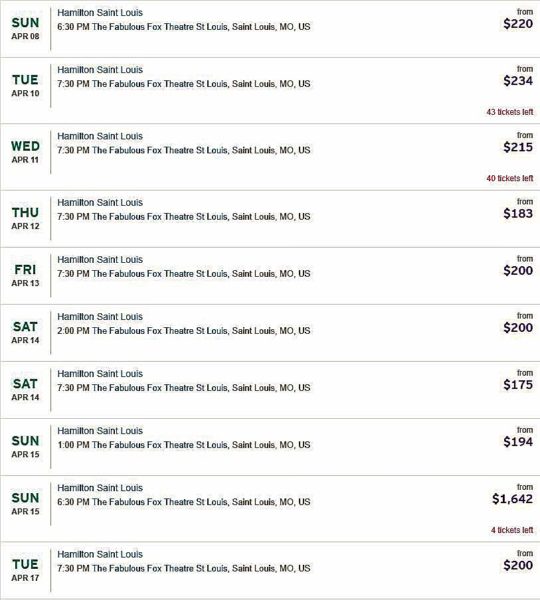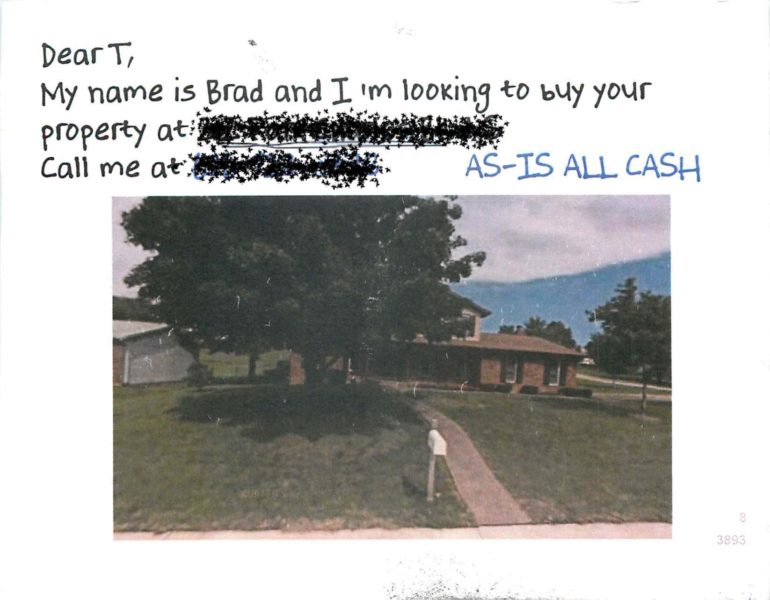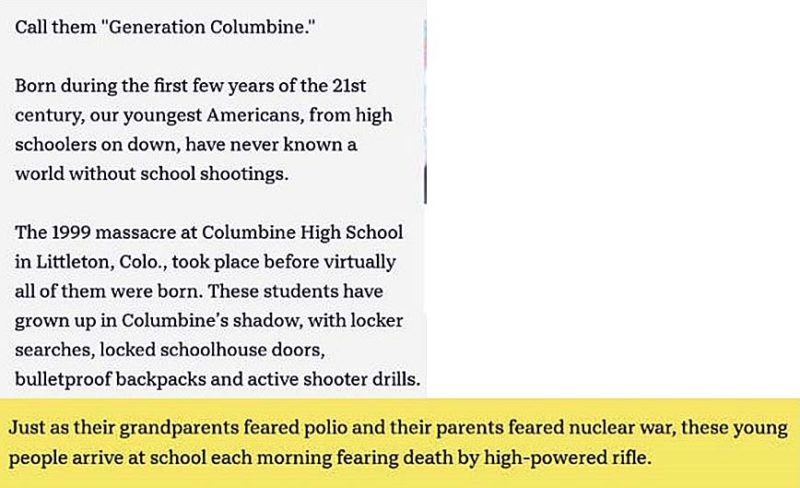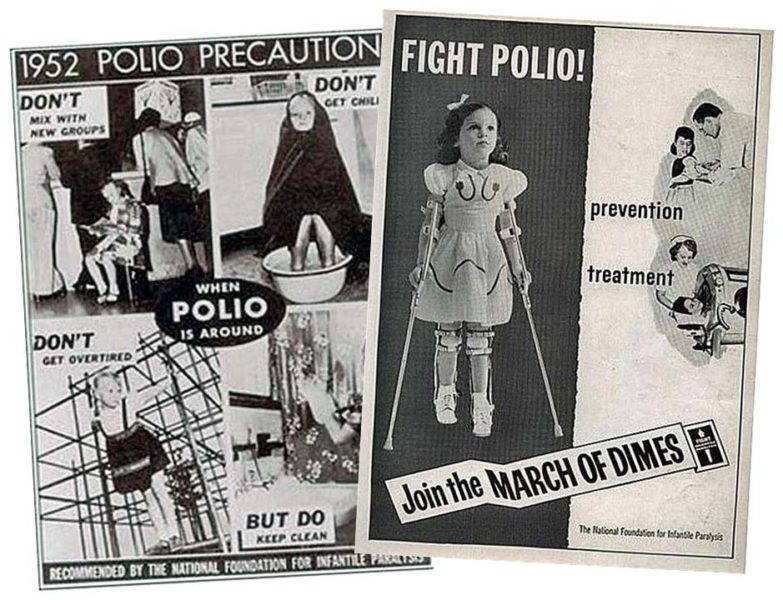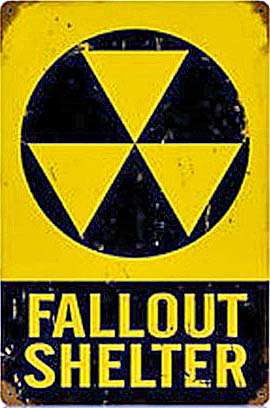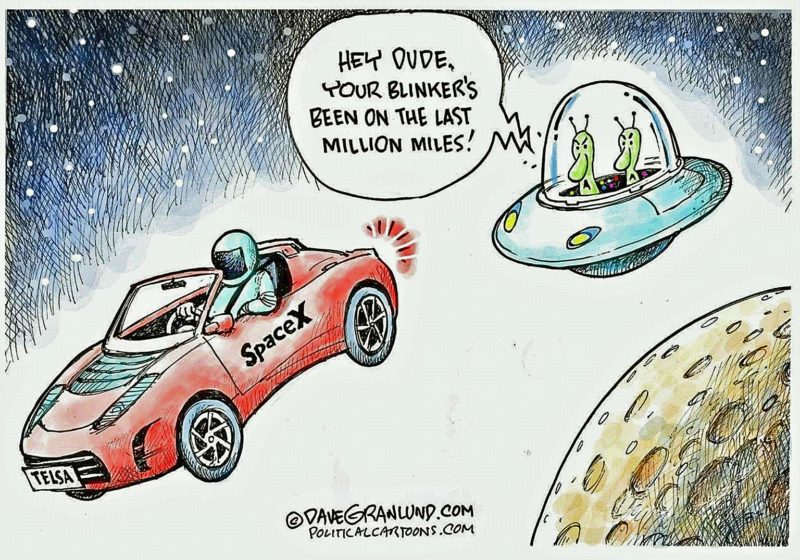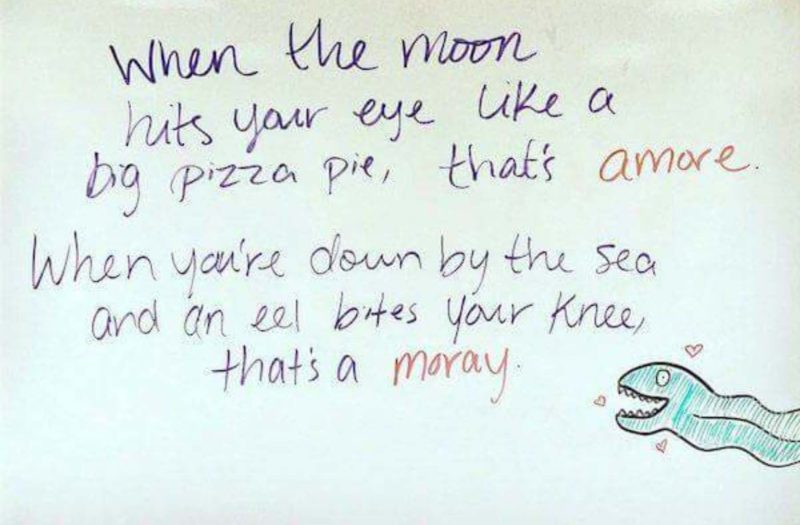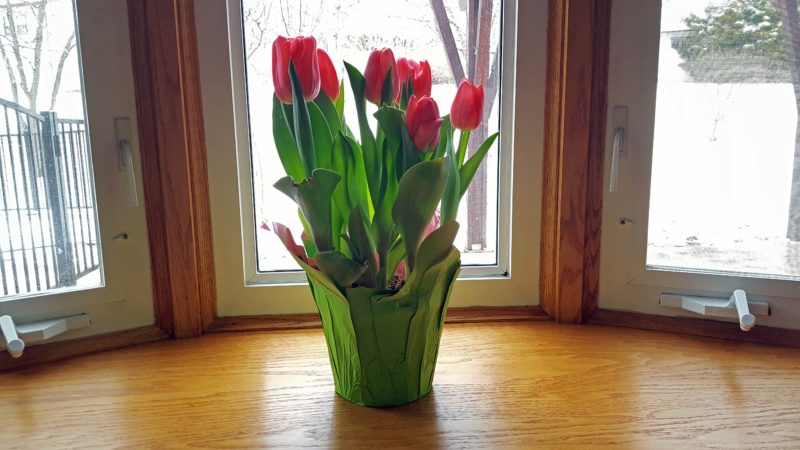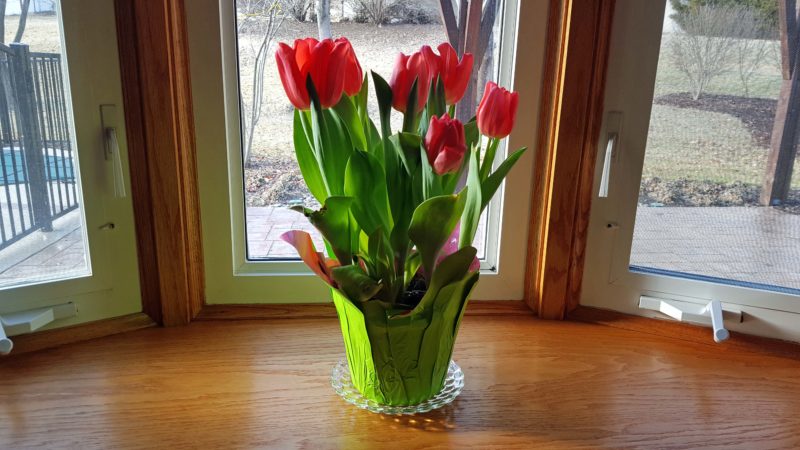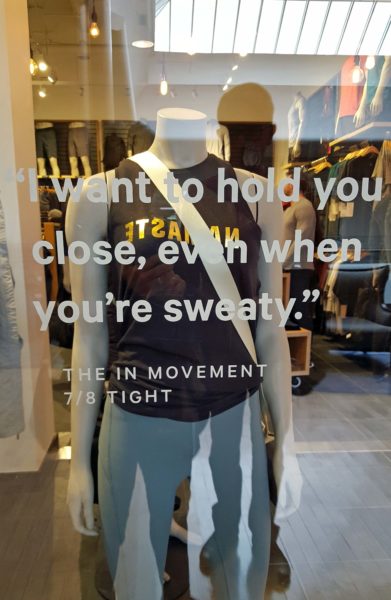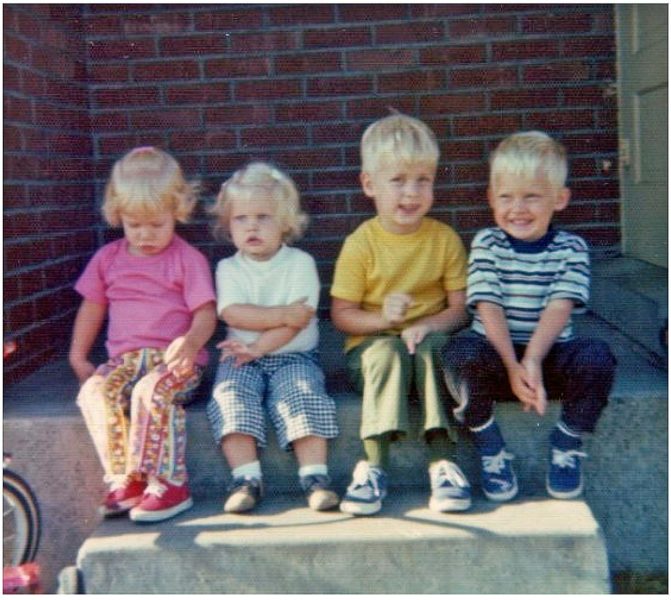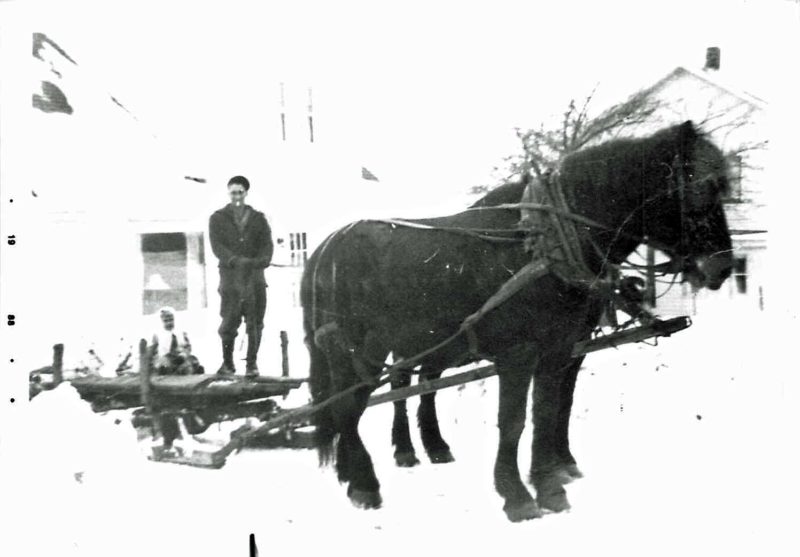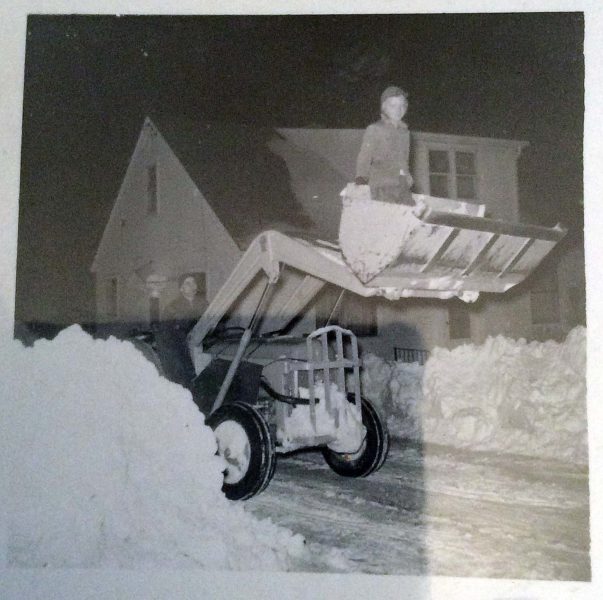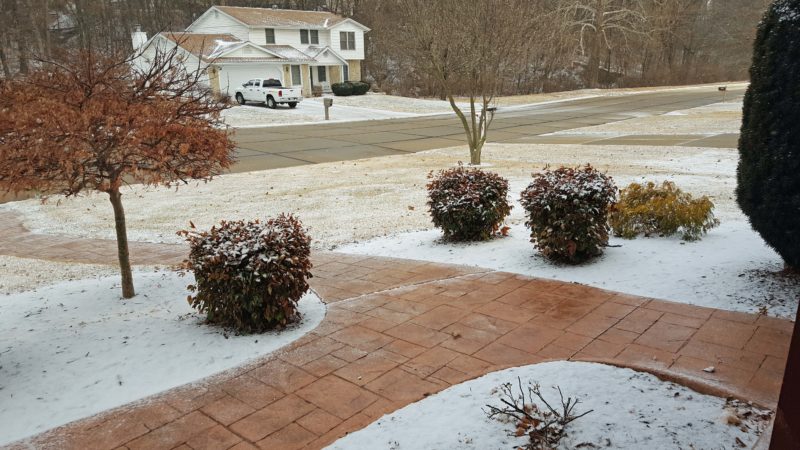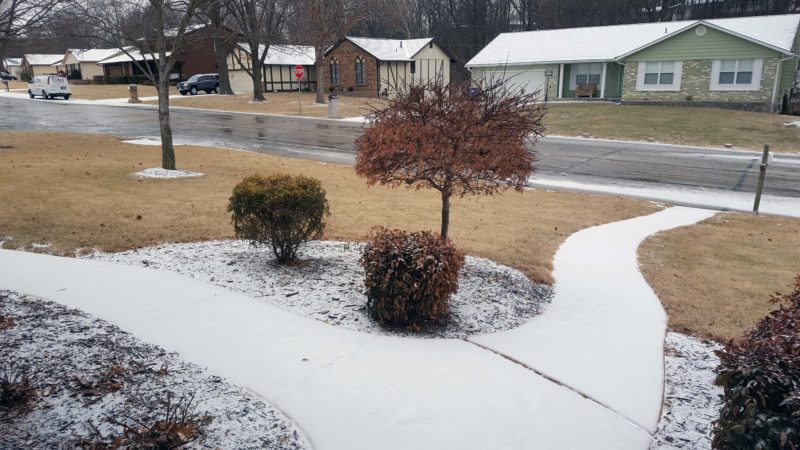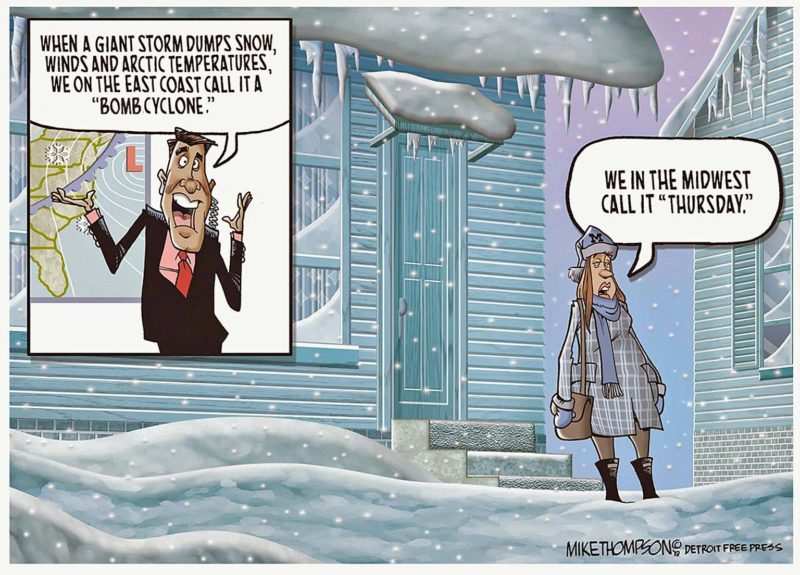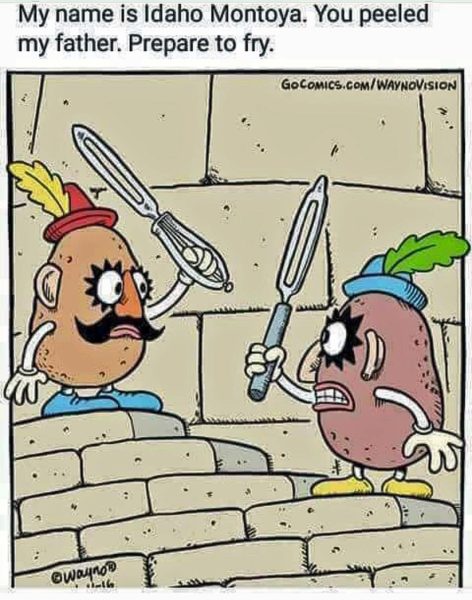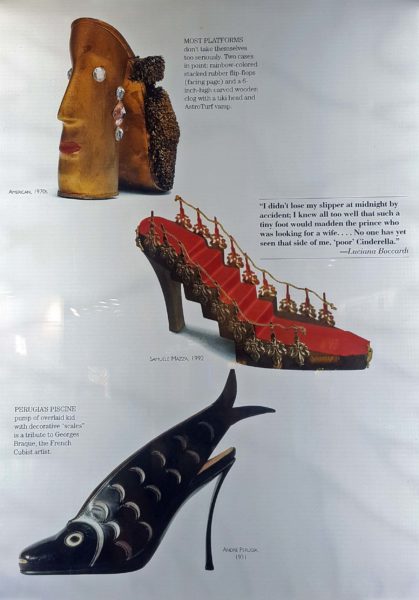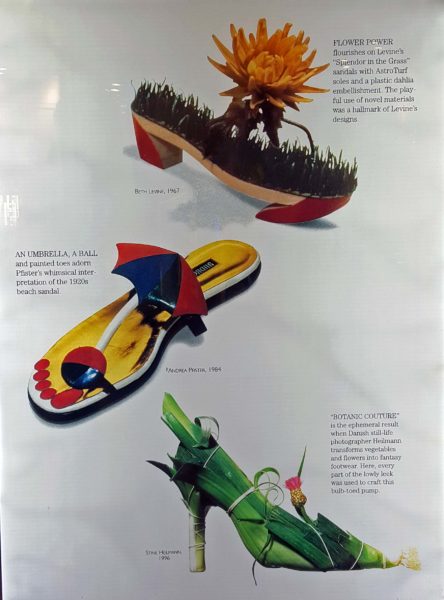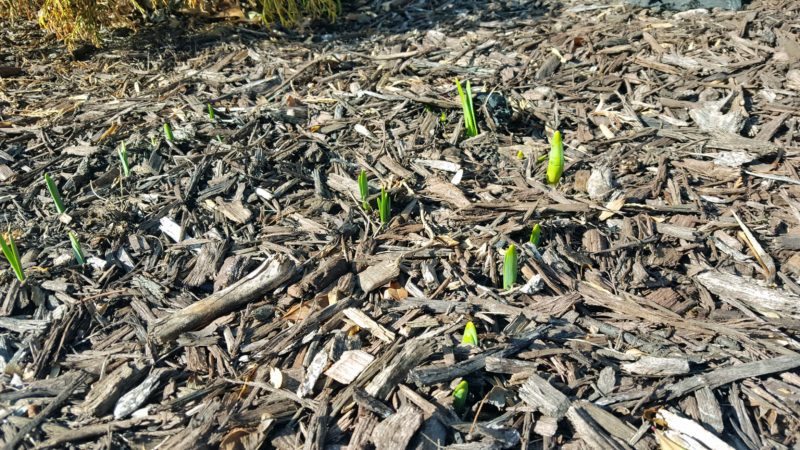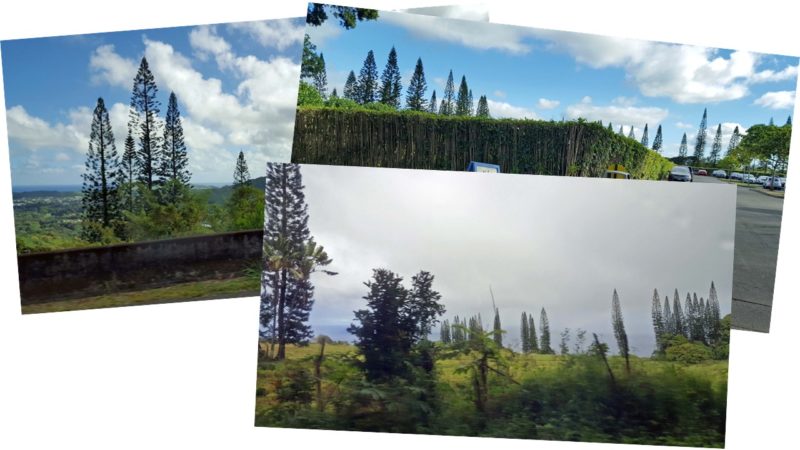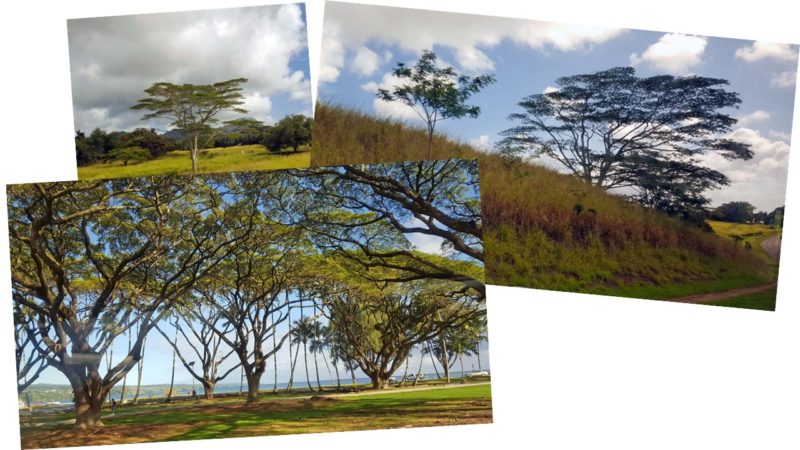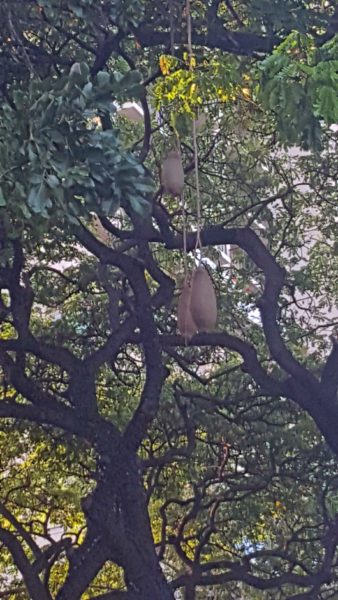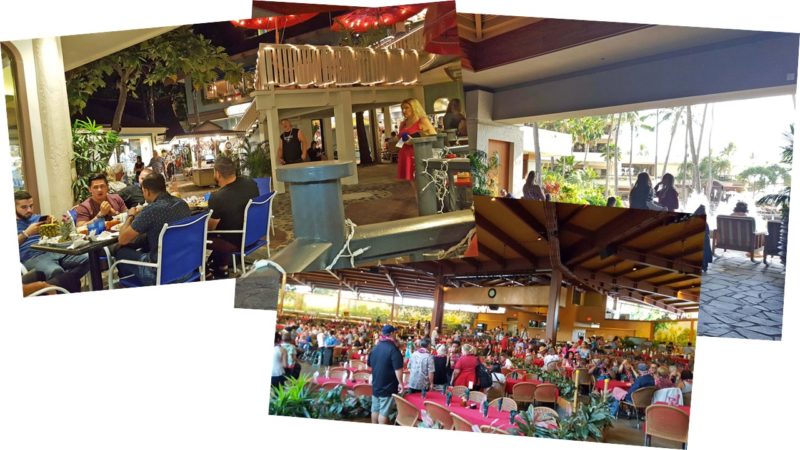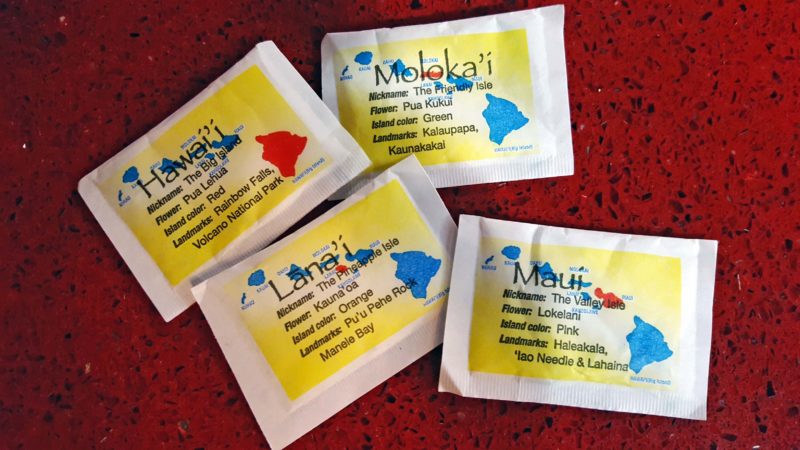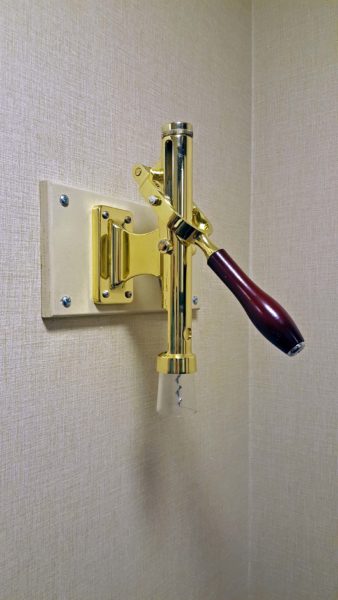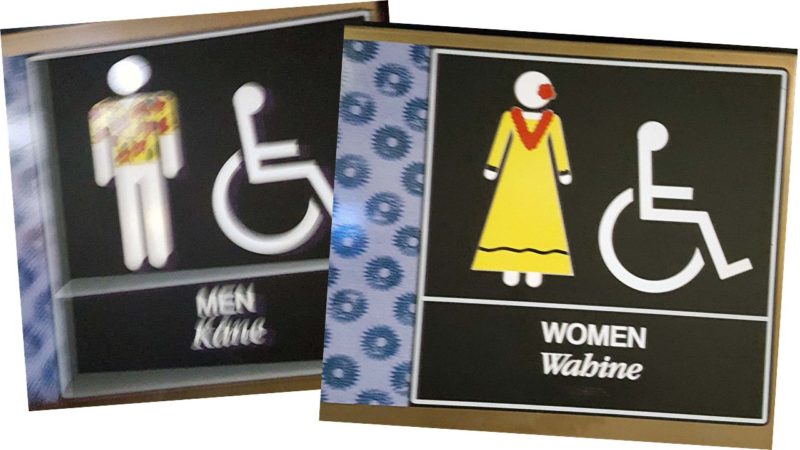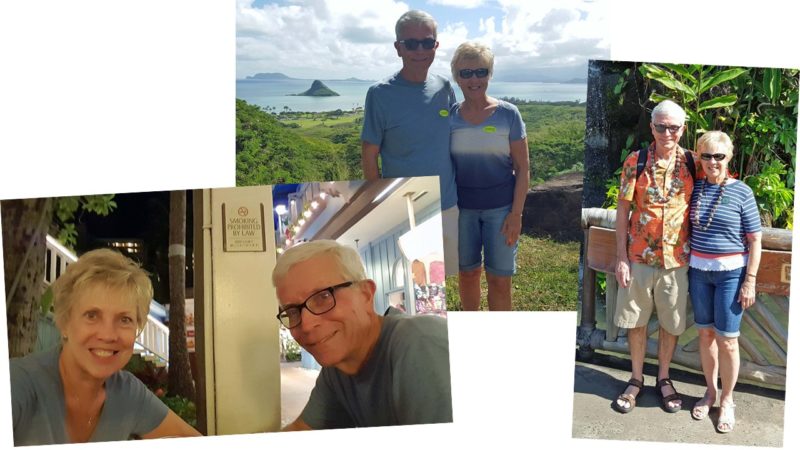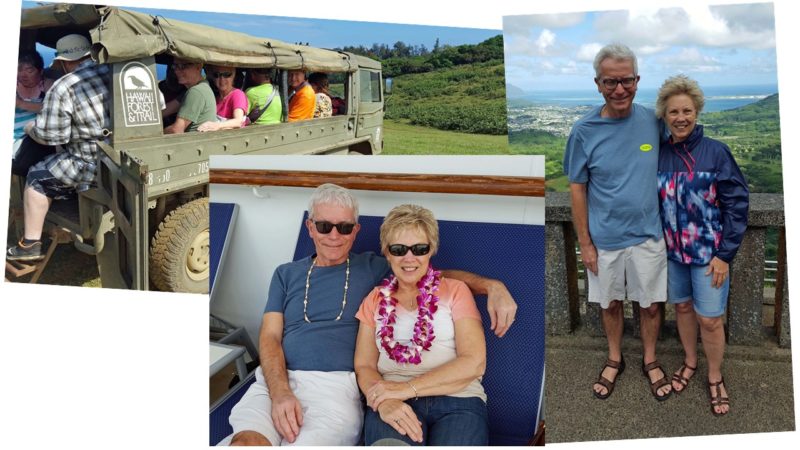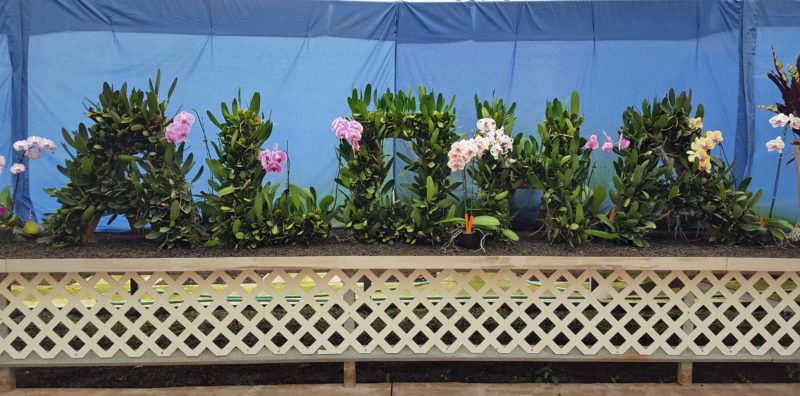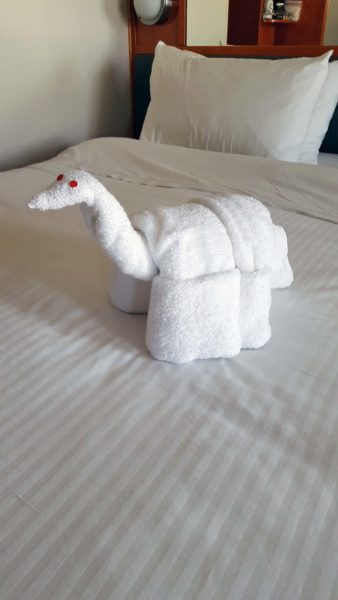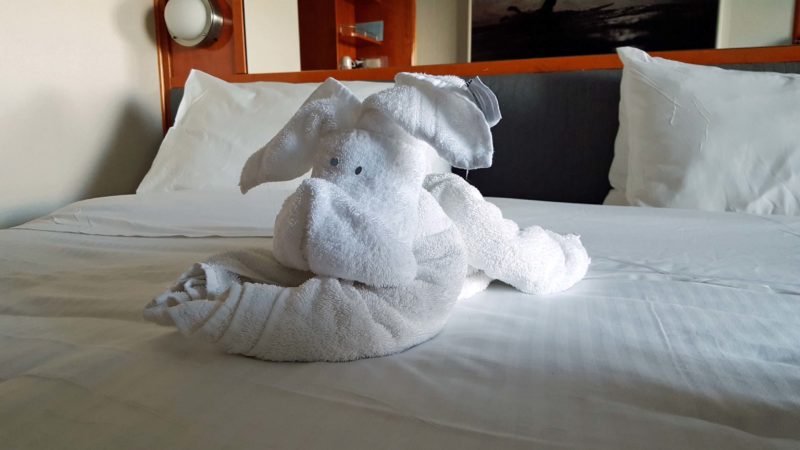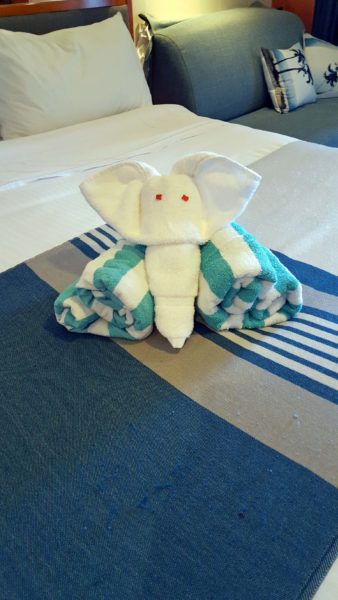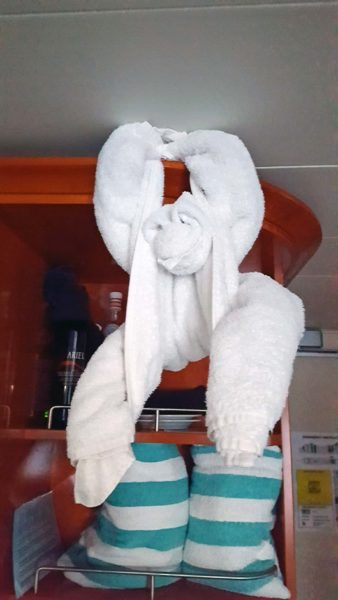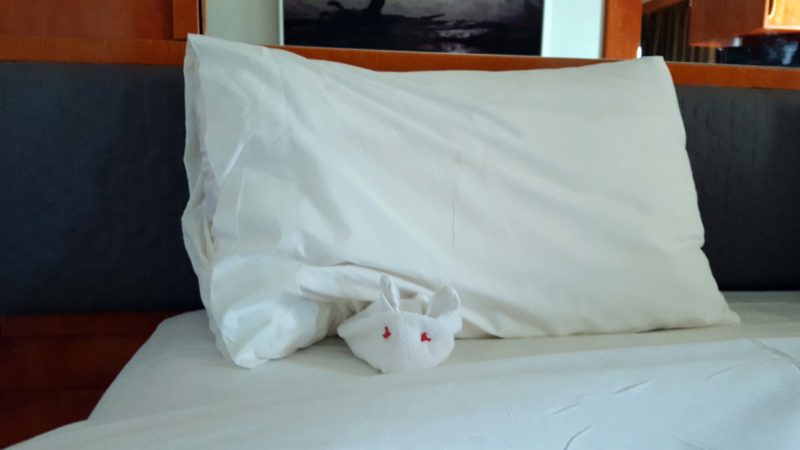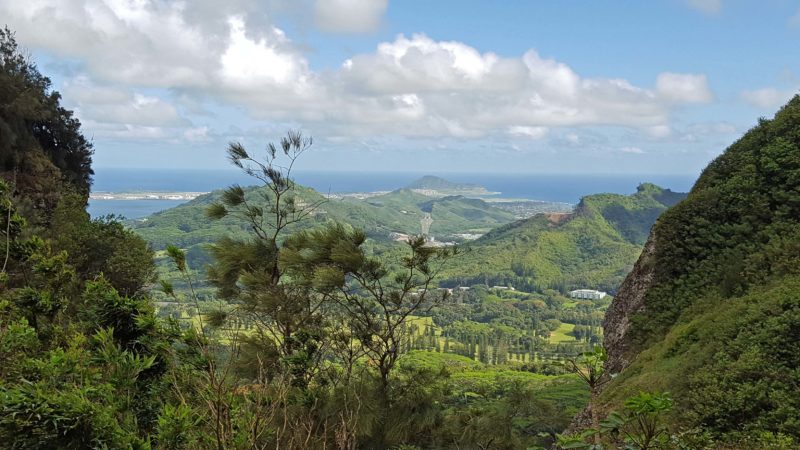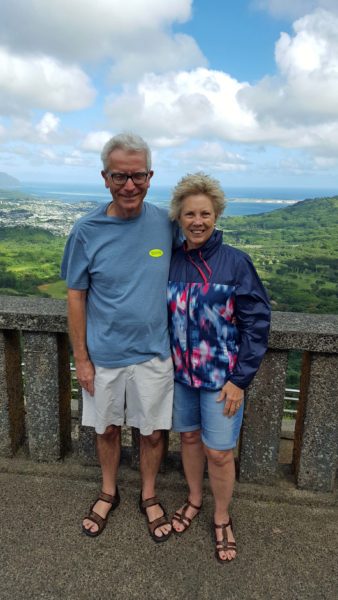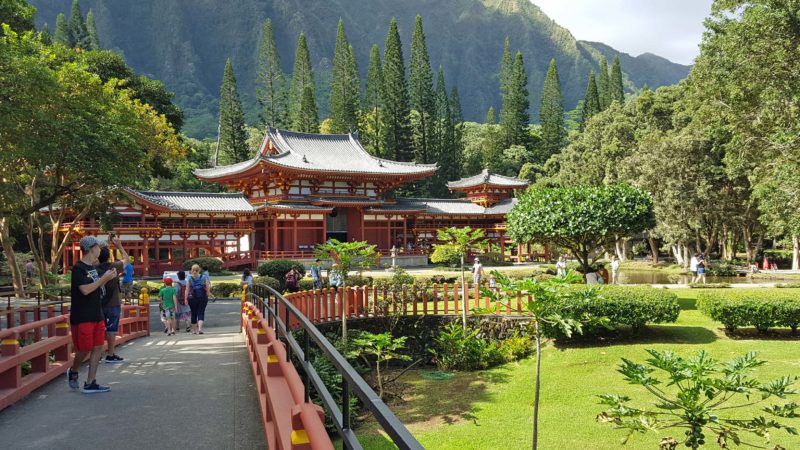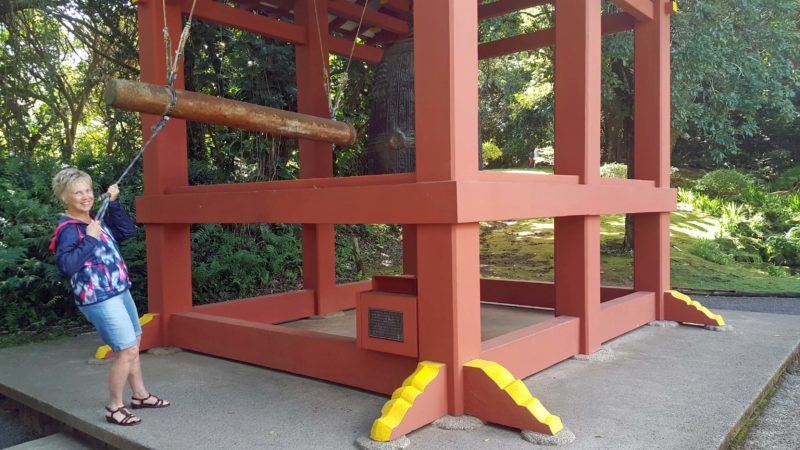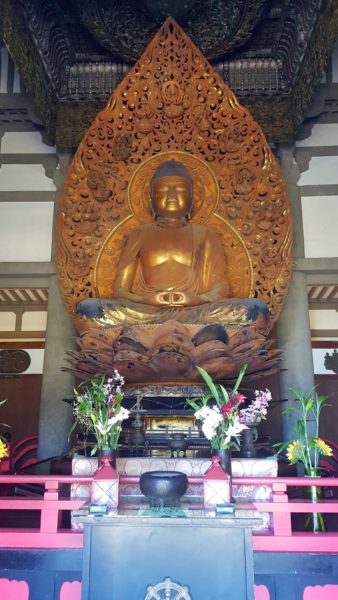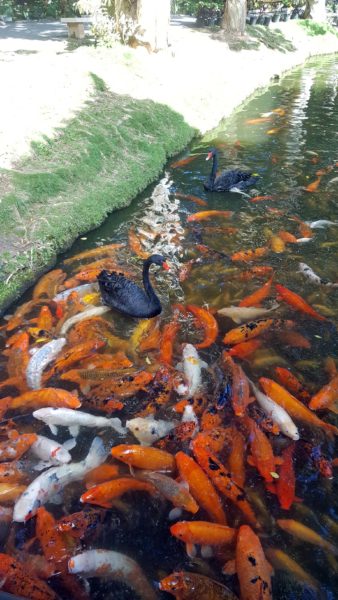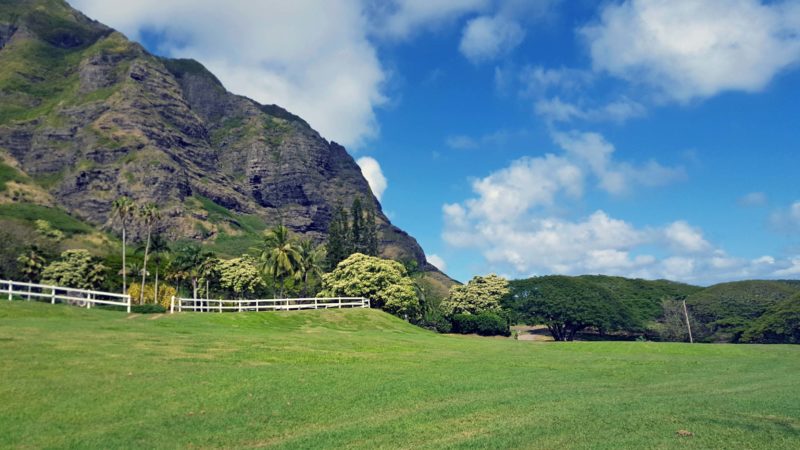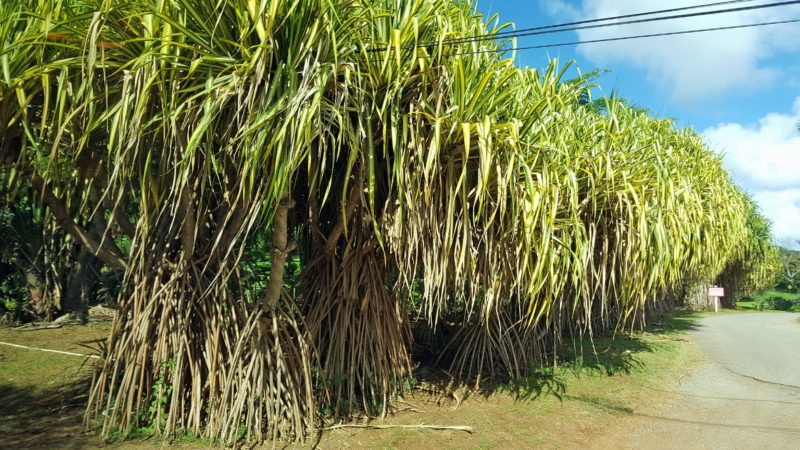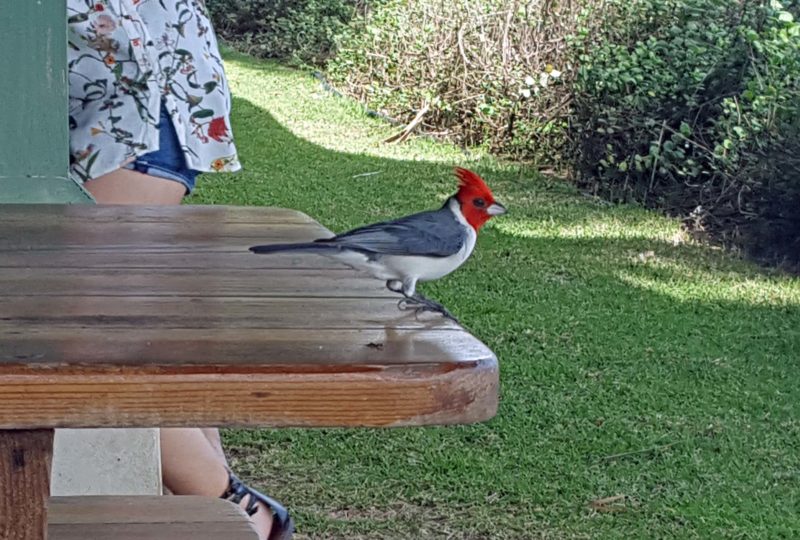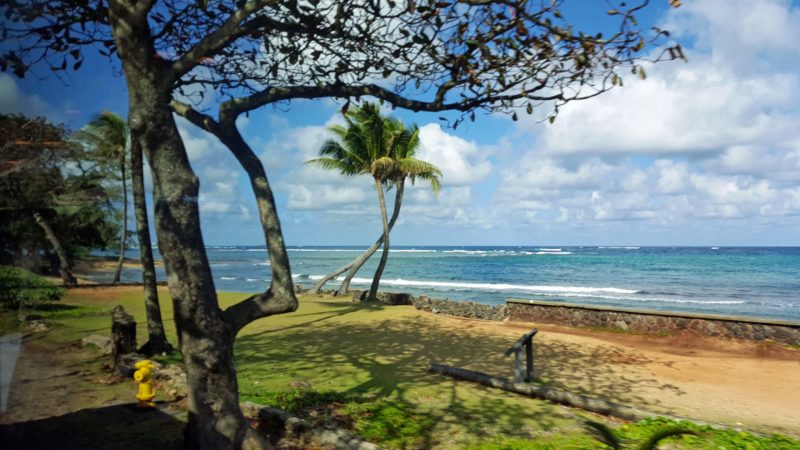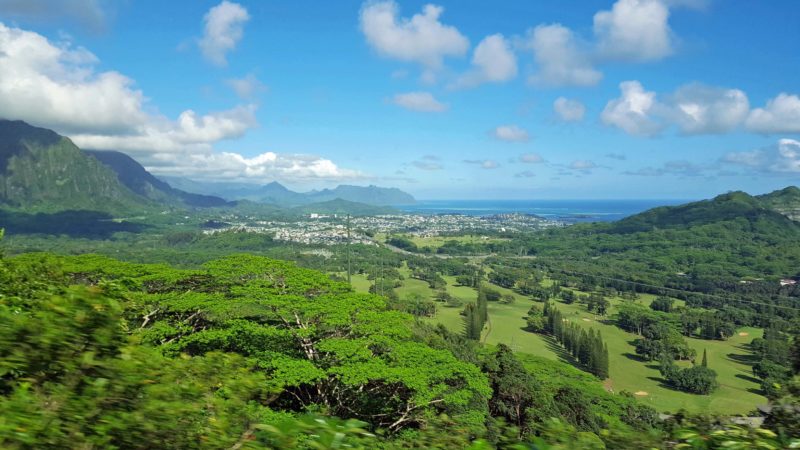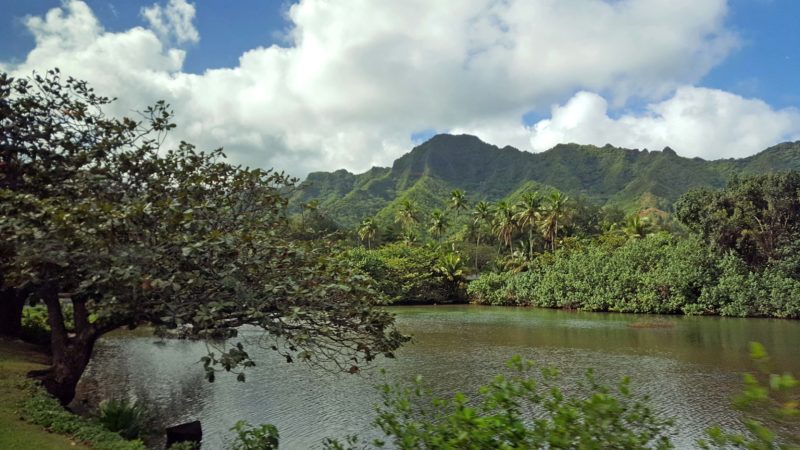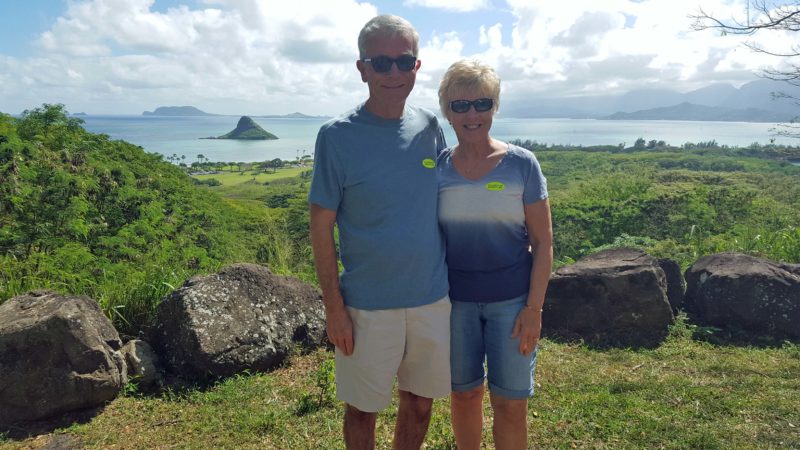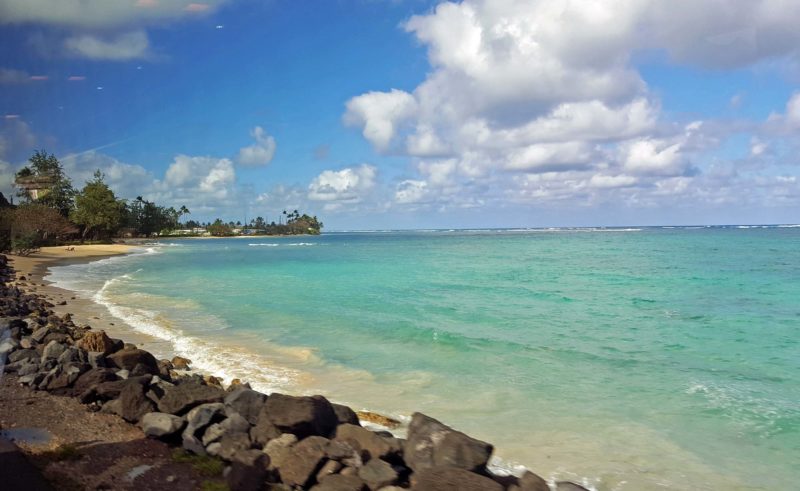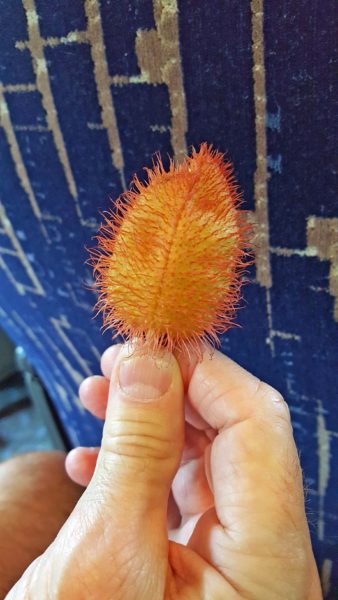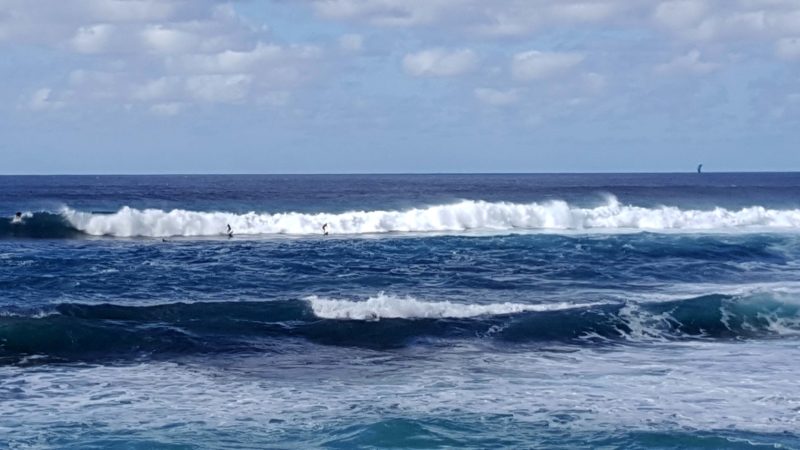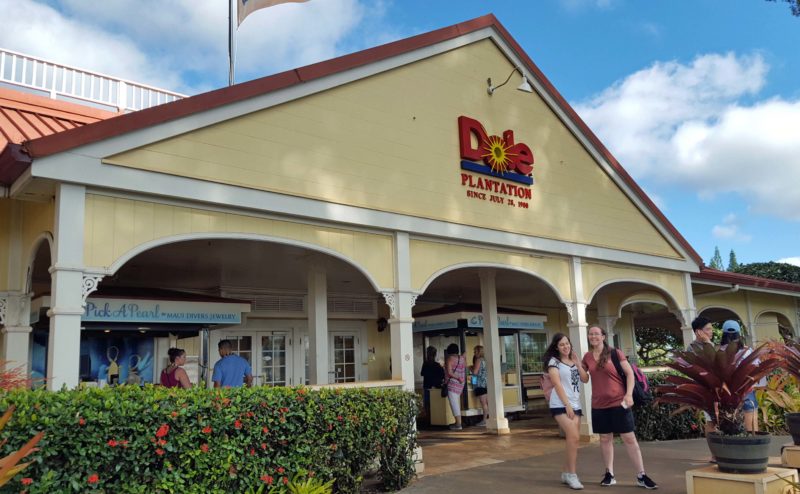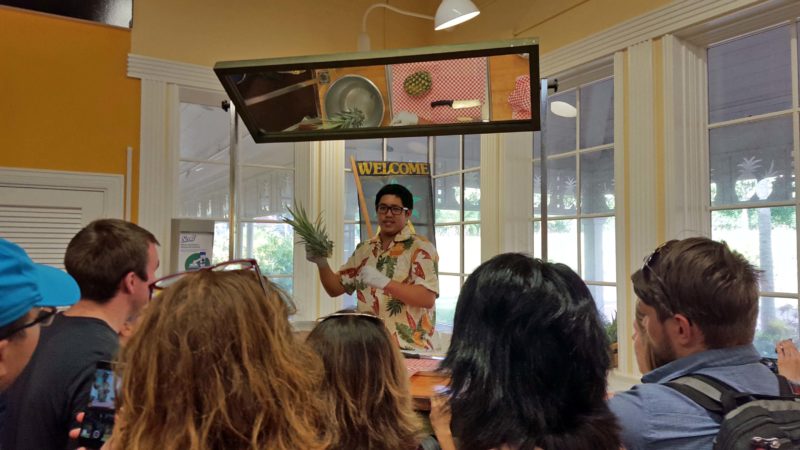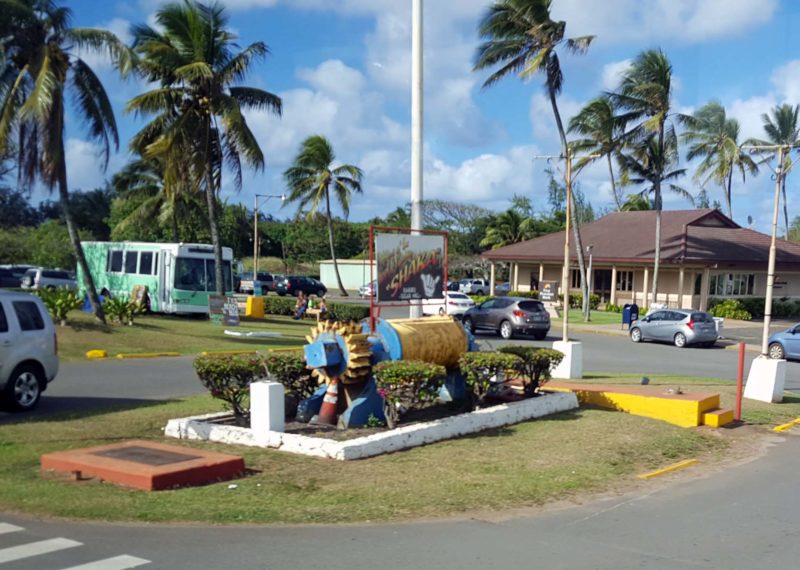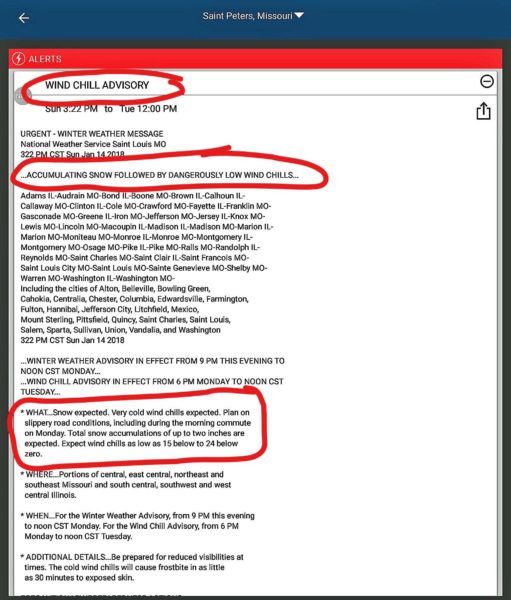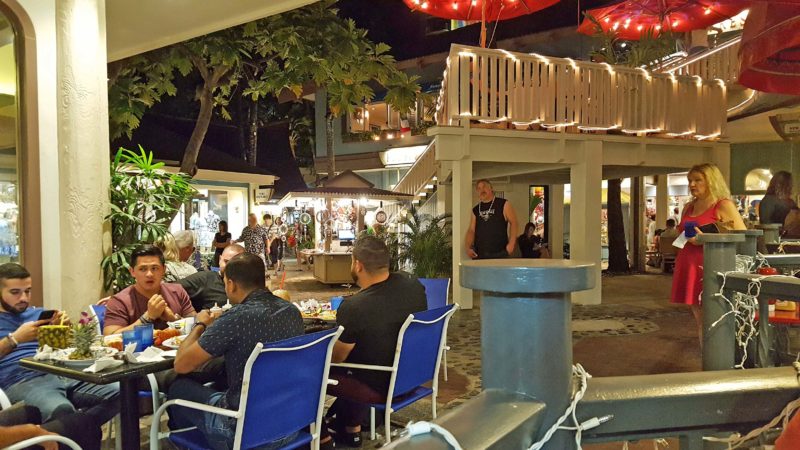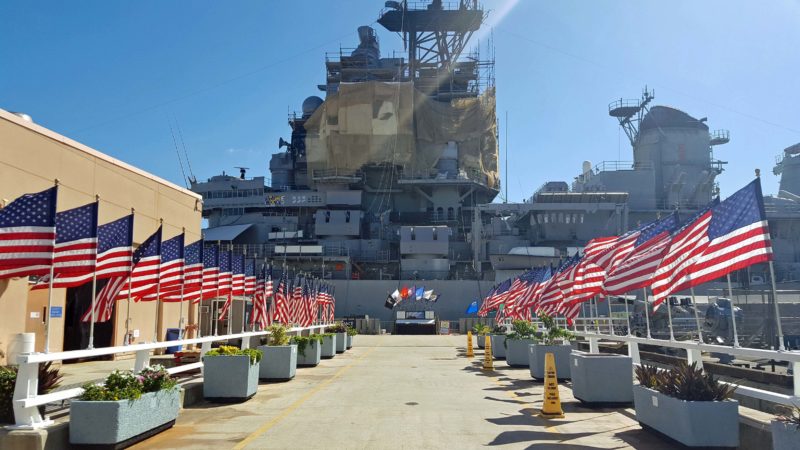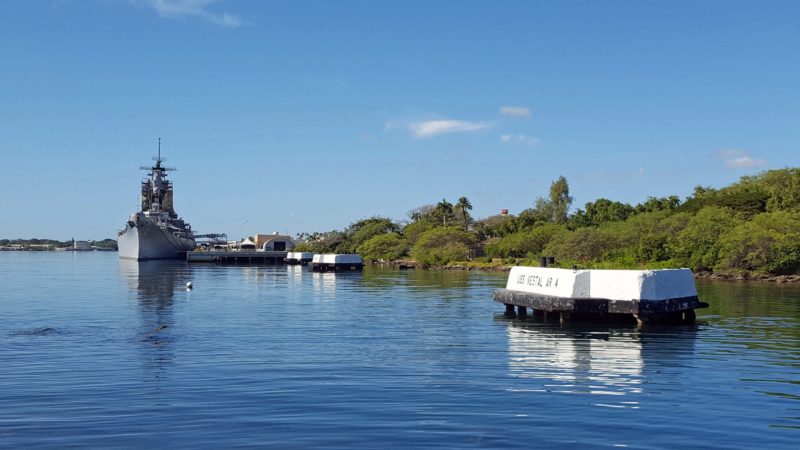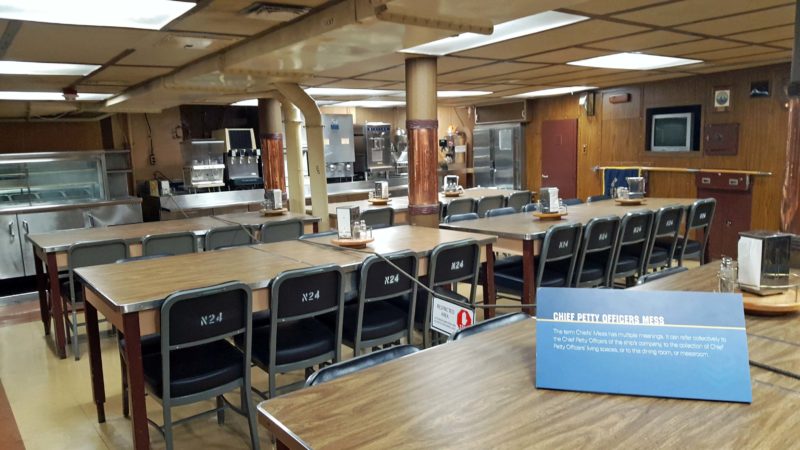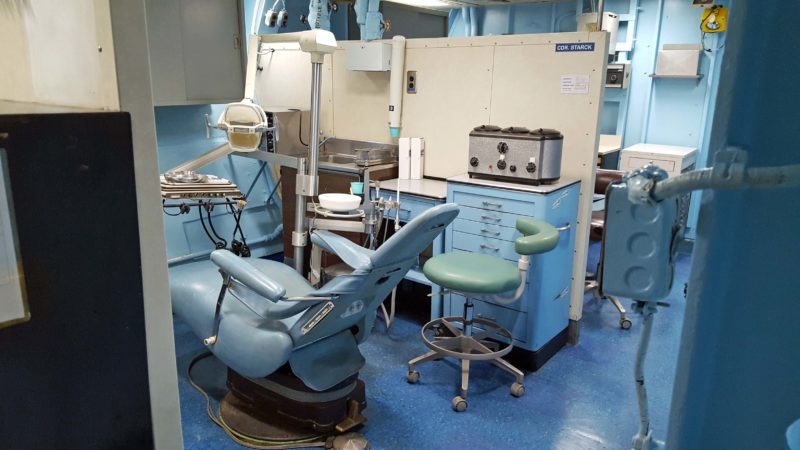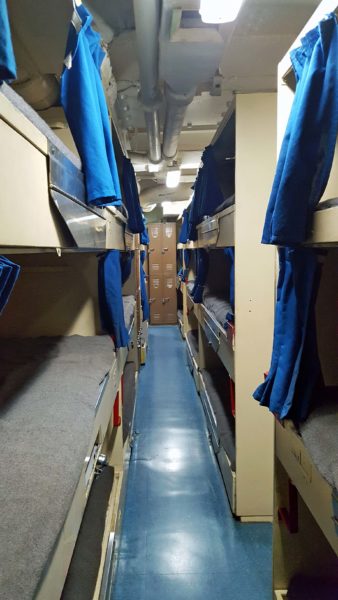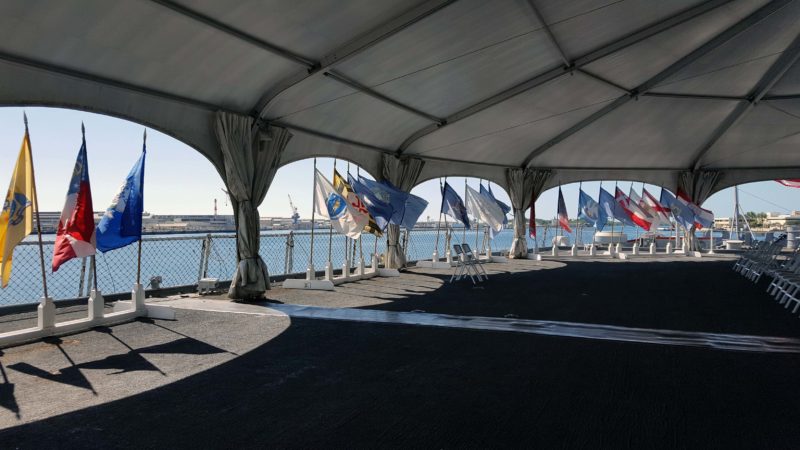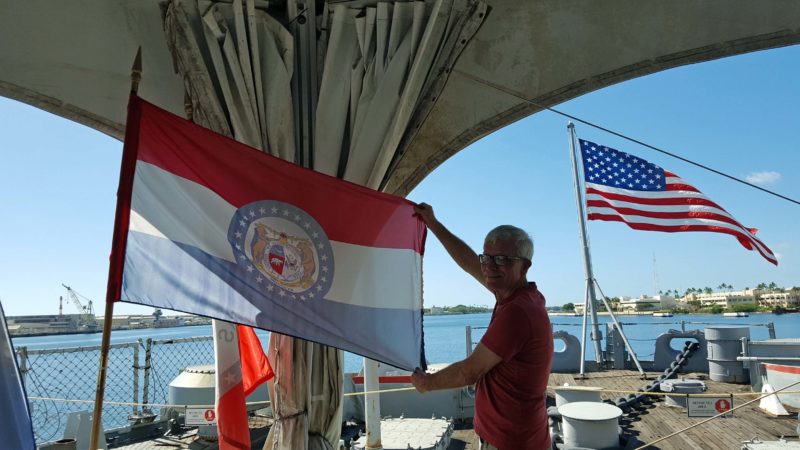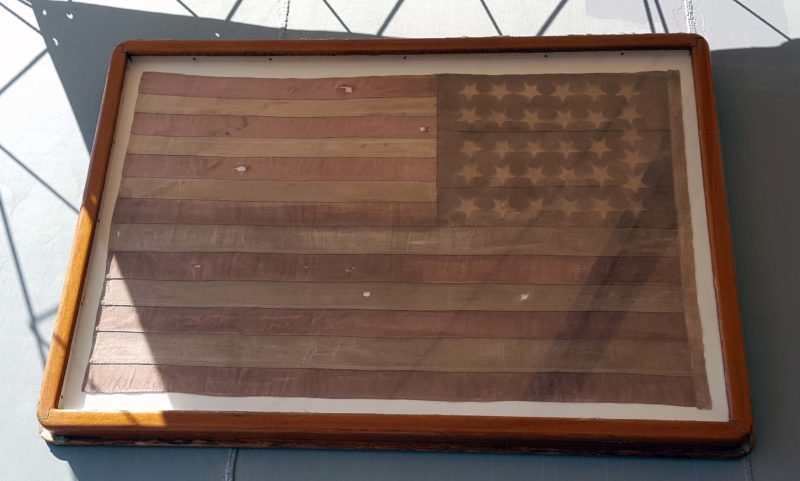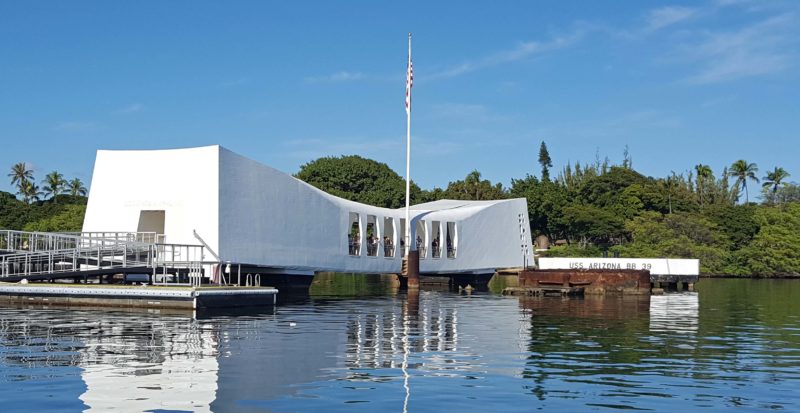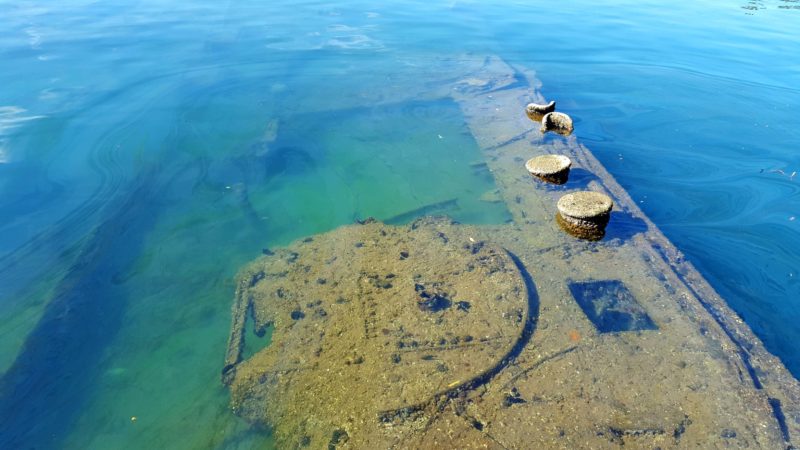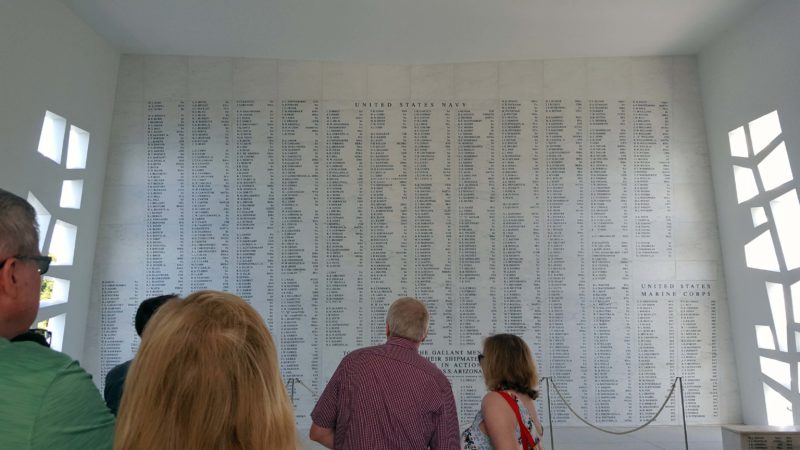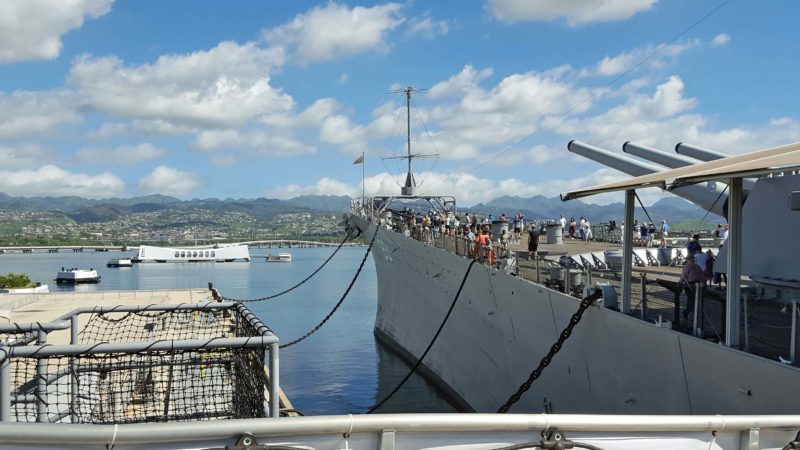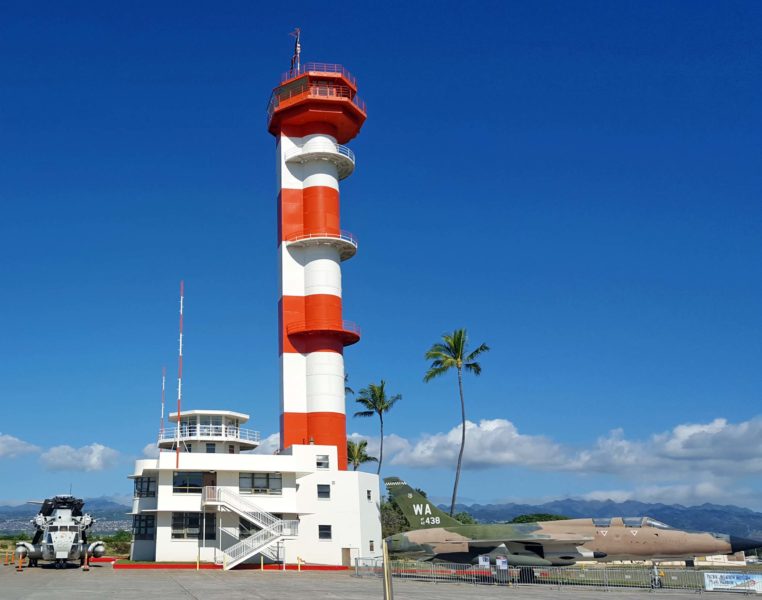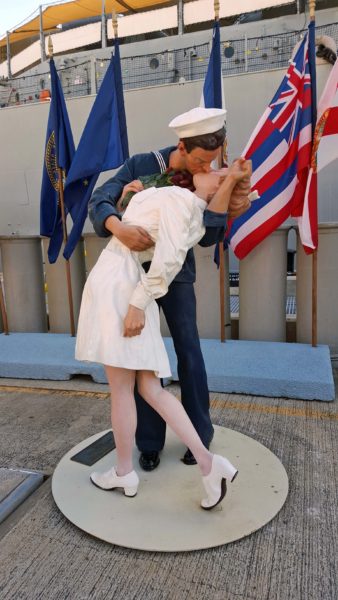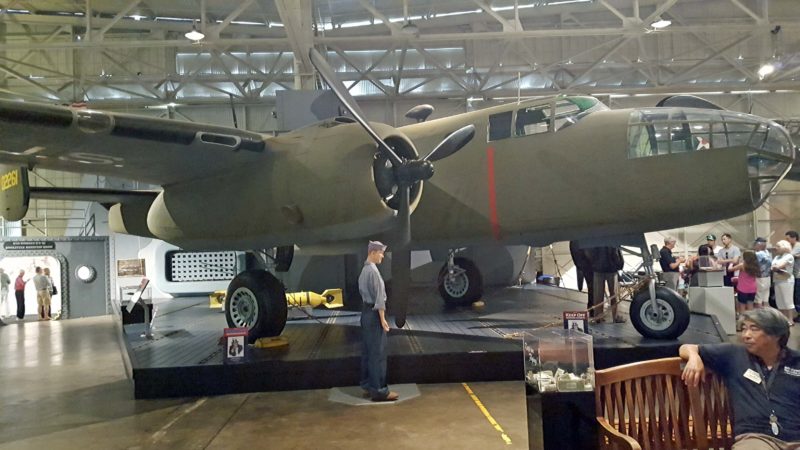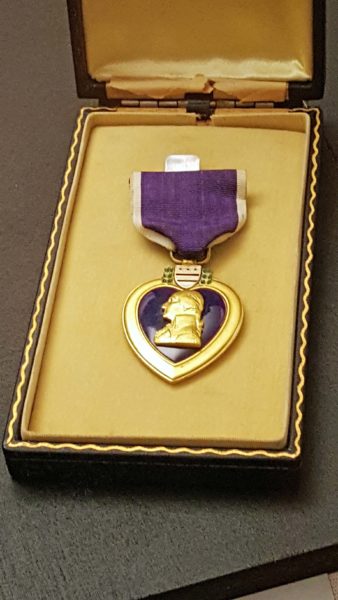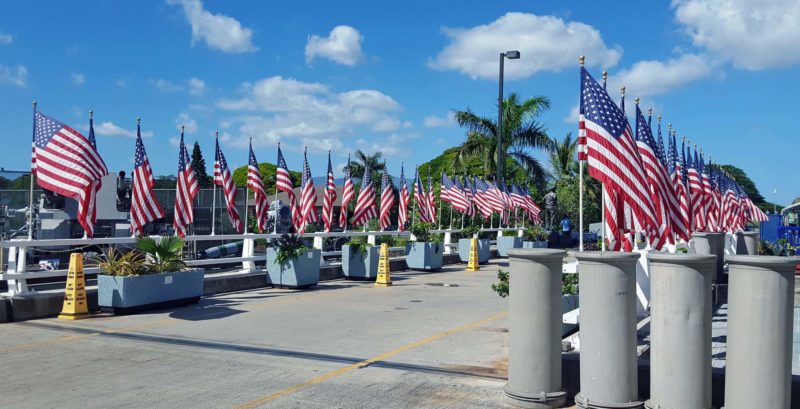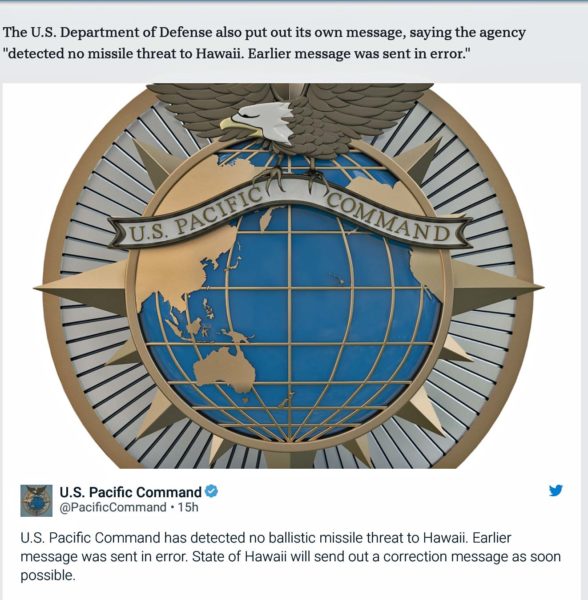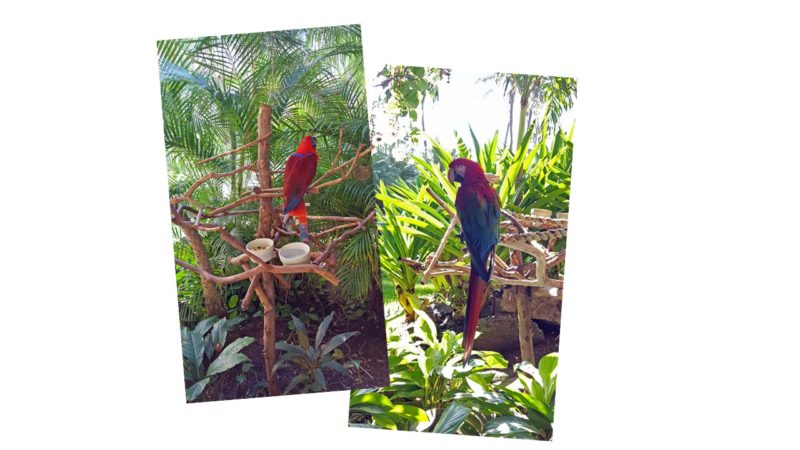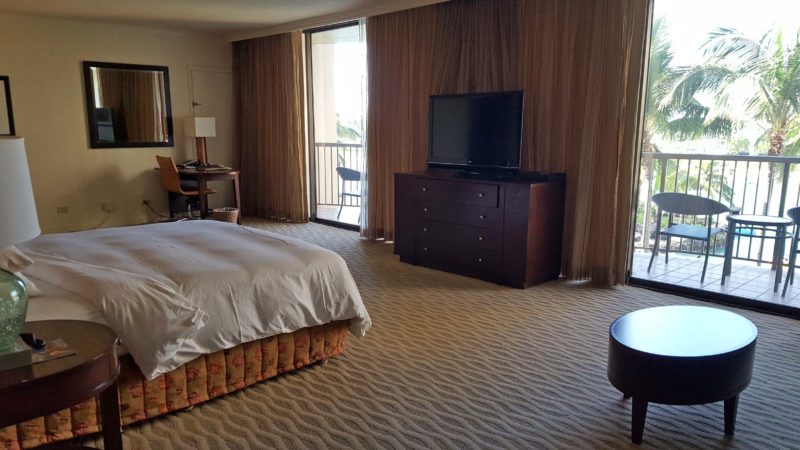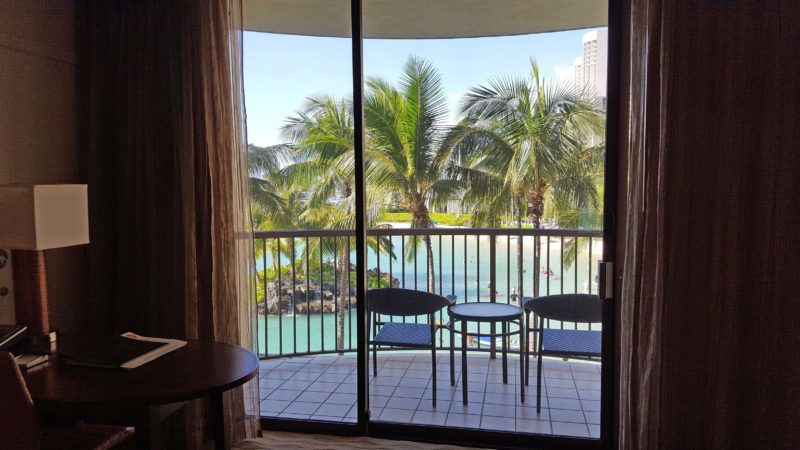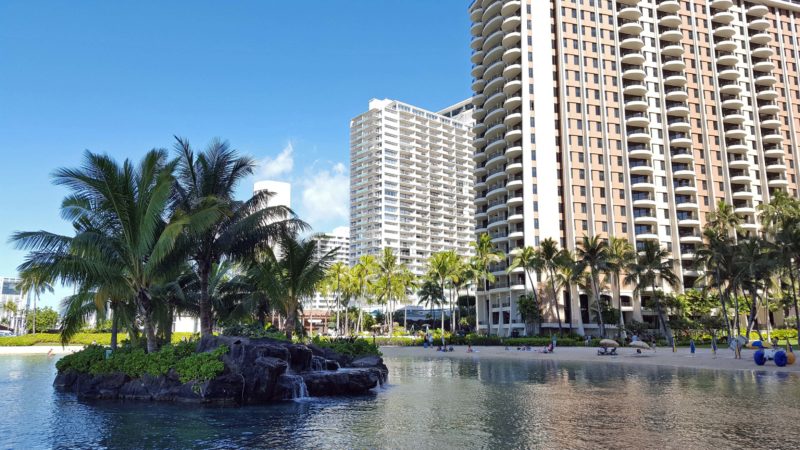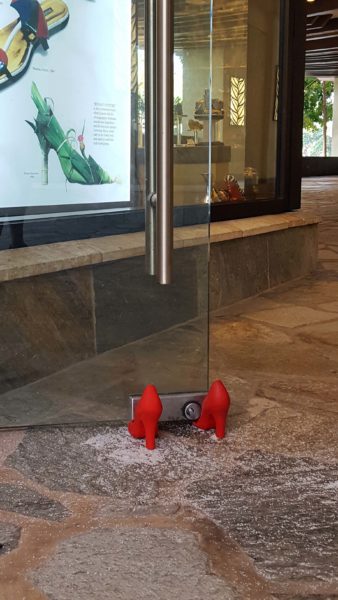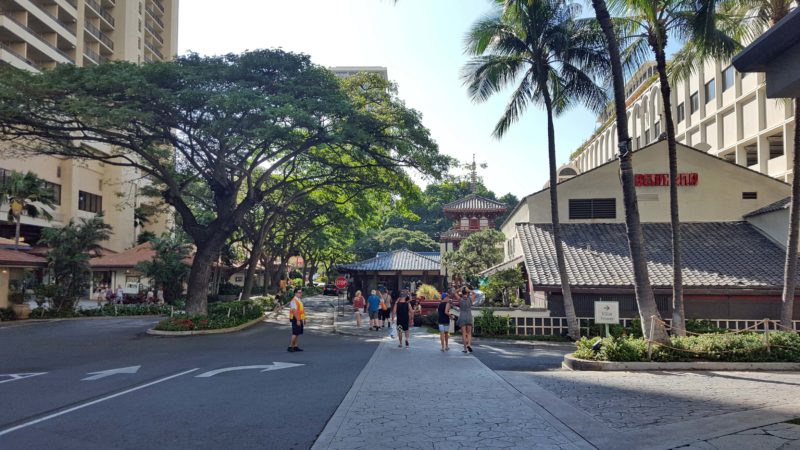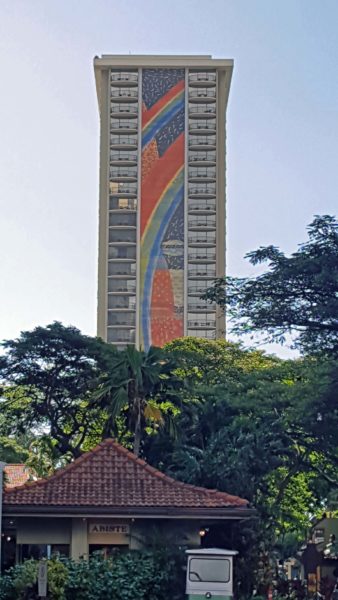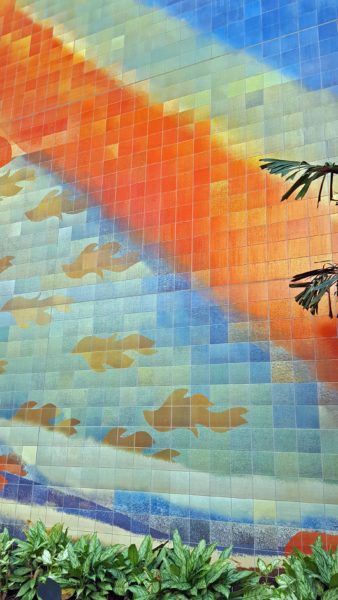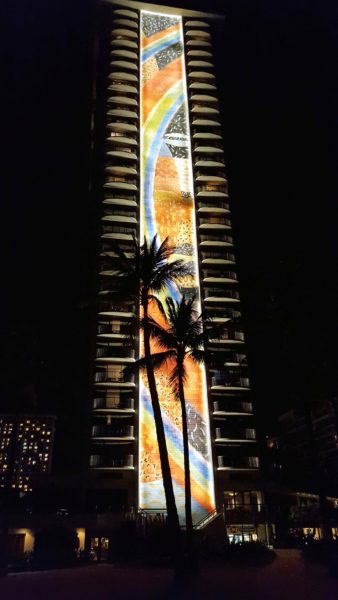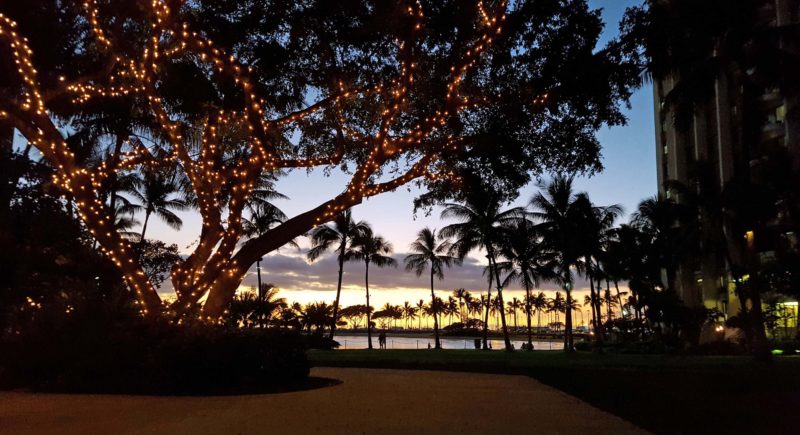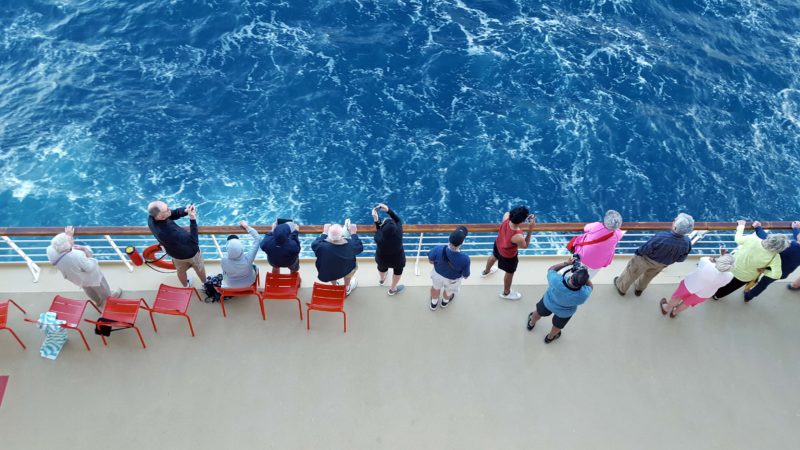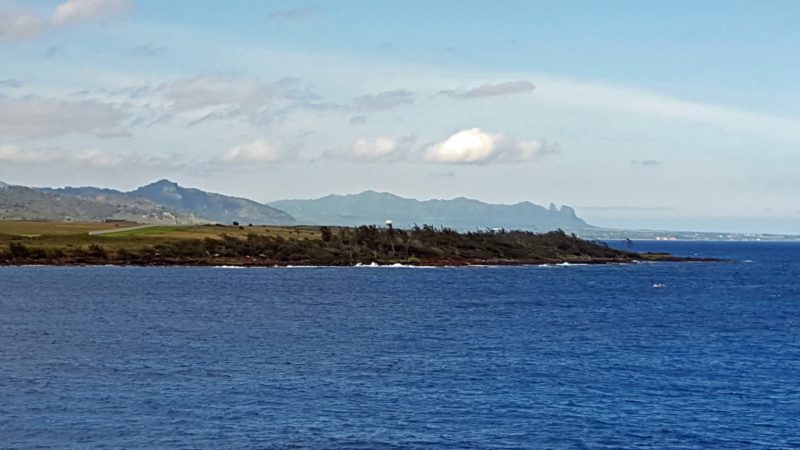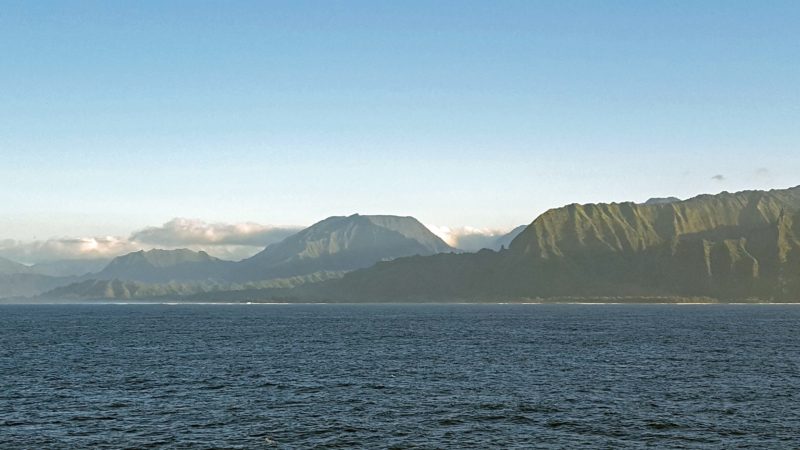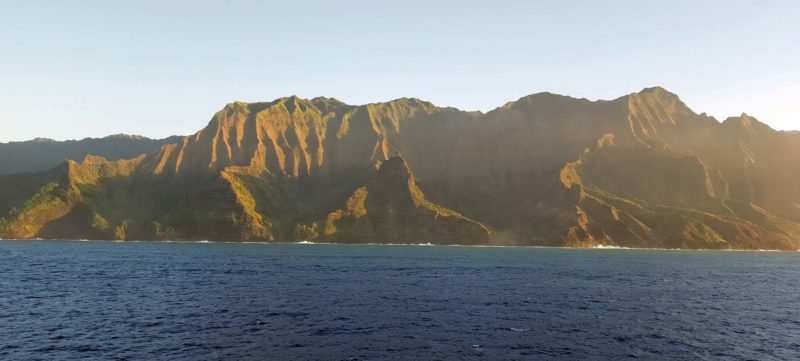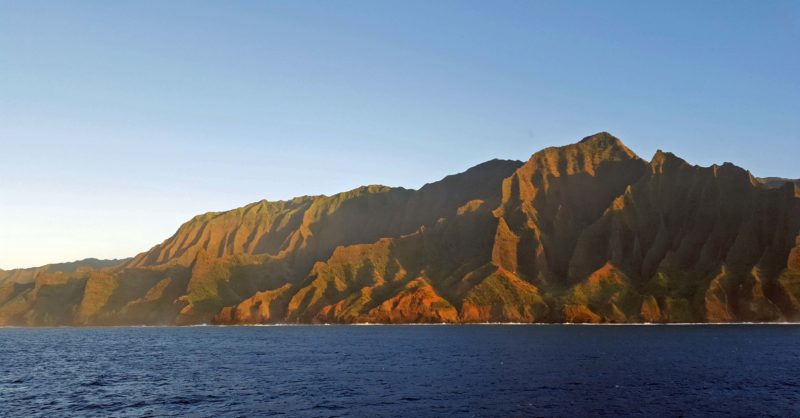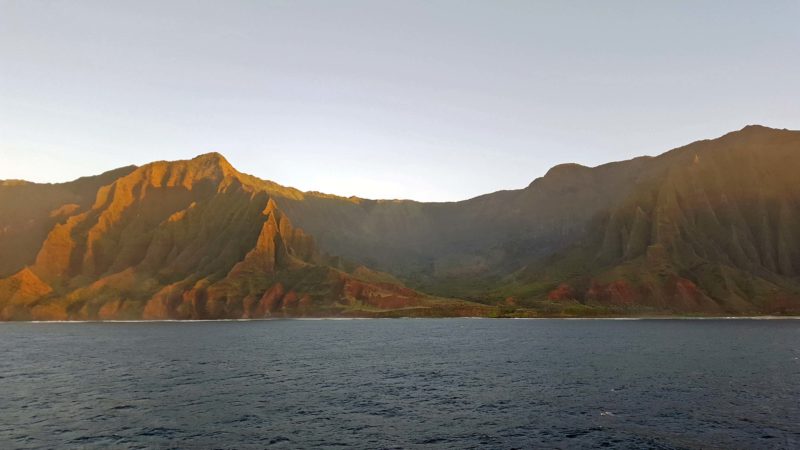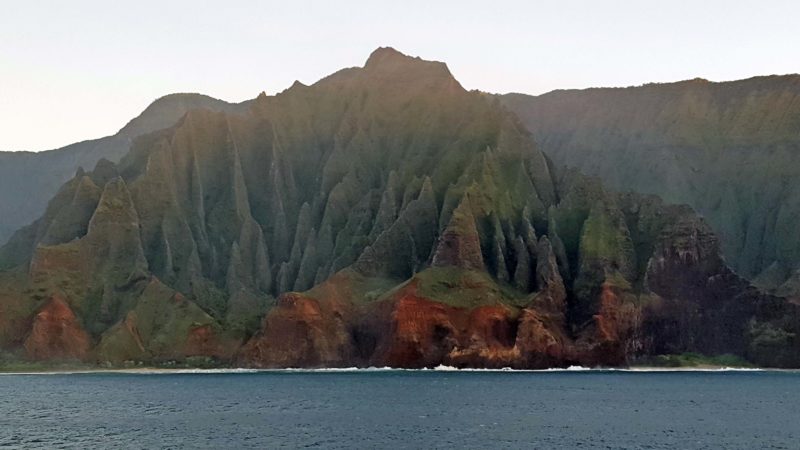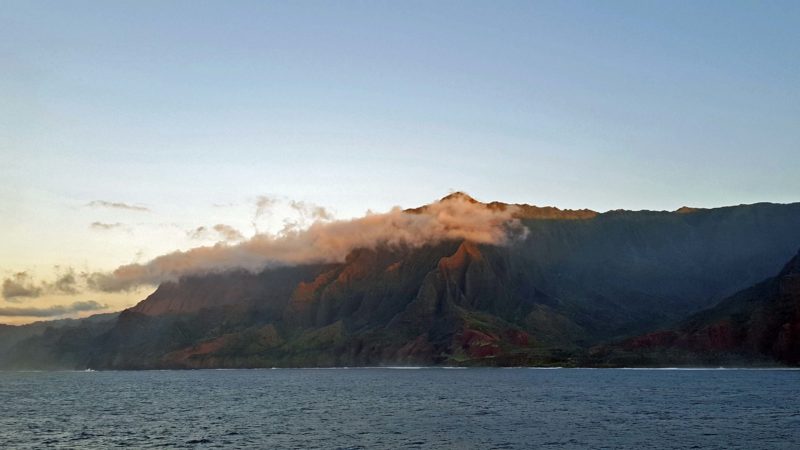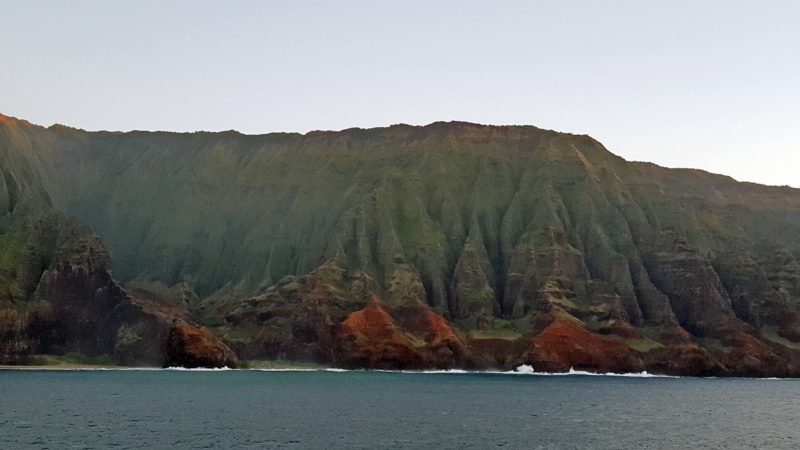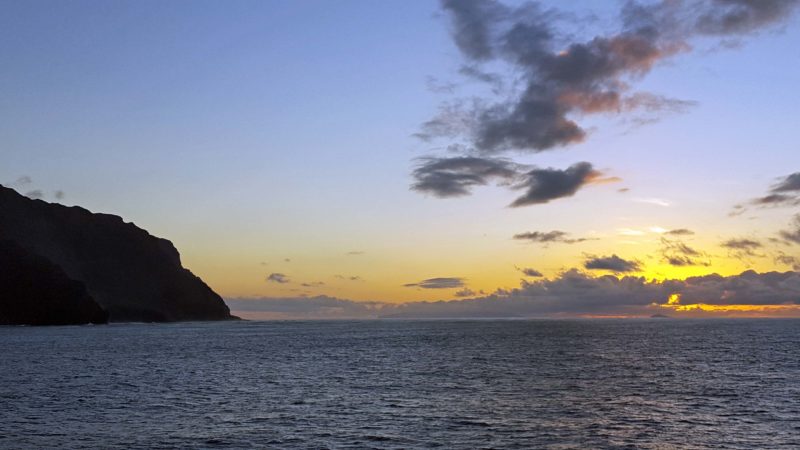Today is the official Martin Luther King Jr. holiday, so Honolulu started the day with a parade.
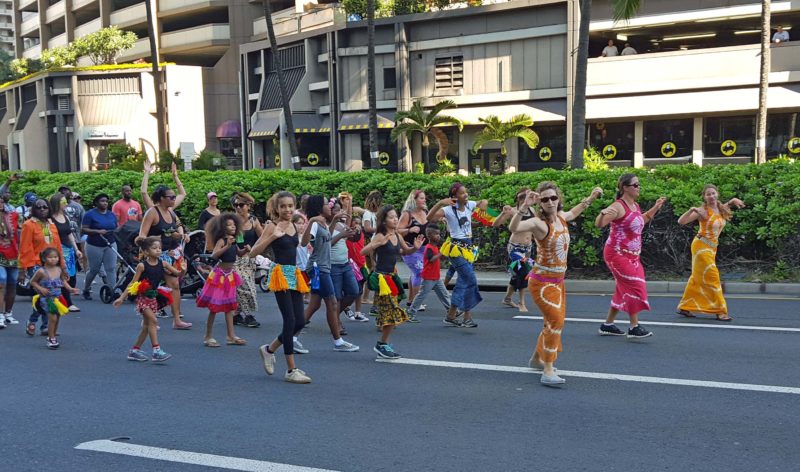
There were a lot of marching/walking groups, cars with politicians and beauty contest winners, and Polynesian dancers.
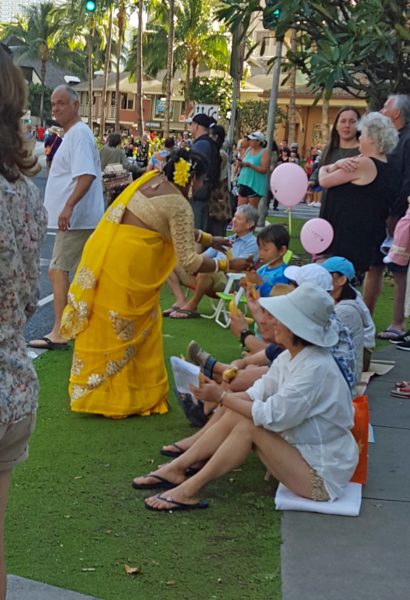
The Hari Krishna had a large float. Members of the group walked alongside the float and handed out bananas to parade watchers. Remember when the Hari Krishna handed out flowers at airports?
Our excursion bus picked us up in front of the hotel along the parade route. The Polynesian Cultural Center (PCC) is on the opposite side of O’ahu from Honolulu, but the drive isn’t as far as mainlanders like us might think. We had to take two of the three interstate highways in Hawai’i: I-1 and I-2. (Guess what the third one is numbered.) Without traffic, the drive would have been about an hour. People from the eastern side of O’ahu regularly commute to Honolulu for work. The scenery all the way is gorgeous, like all of Hawai’i, but this is my favorite scenery photo of today’s trip.
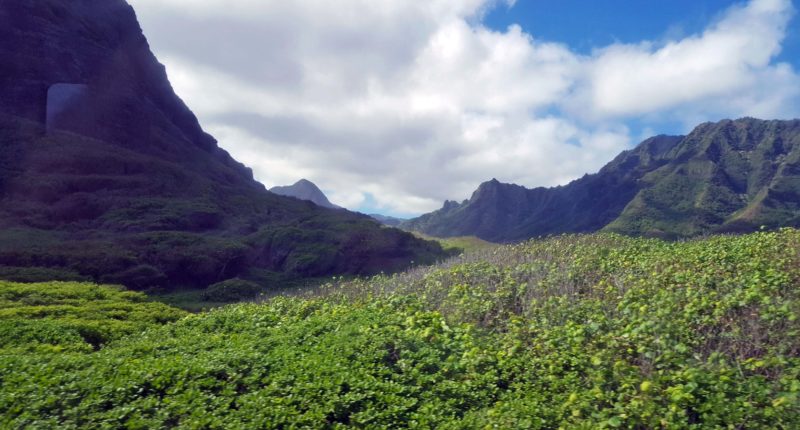
It’s a breathtaking view. If you think it looks familiar, you might have seen Jurassic Park.
Ted and I had purchased all-day PCC tickets that allowed us to explore the park on our own, eat lunch on our own, partake of the the buffet dinner (included in the ticket price), and watch the closing performance. Well, the guide on the bus earns his salary, because I think he talked everyone on the bus with basic ($90) tickets (most of us) into upgrading at an additional cost of about $150/couple. Is this built into the experience? A cynical person would say “yes.” Here were the advantages of the upgrade:
(1) The park is open from noon until 6:00 p.m. The evening performance begins at 7:30. (2) If you order lunch in advance instead of eating on your own, your order (choose 1 of 3 meals) will be called in from the bus and you will be able to enter the restaurant and eat immediately upon arrival at the park, allowing more time to enjoy the exhibits. (3) Paying for a tour guide will assure that you arrive at each of the six Polynesian “villages” at the time of their main performance. (4) The included buffet dinner is served at 4:00 p.m.; the bare-bones luau begins at 4:45 p.m. It takes more than a full day to see everything in the park, so either of these two options cuts deeply into the visitors’ time at the exhibits. (5) The Ali’i Luau Buffet (upgrade) is served at 6:00 p.m., allowing visitors to spend maximum time at the exhibits, and it includes a performance with the meal. It ends just in time to be seated at the 7:30 p.m. evening performance.
Ted and I were not aware of the time constraints of the basic all-day tickets, so we caved to the marketing ploy and upgraded. Having done that, would we do it again? Absolutely! It was well-worth the price to have lunch waiting, see all six cultural performances, and enjoy the full luau experience before ending the day with the evening show. The PCC’s web page has a brief overview of some of the things we saw in the Polynesian villages. It’s a video, so it shows the quality of our day better than my still photos do.
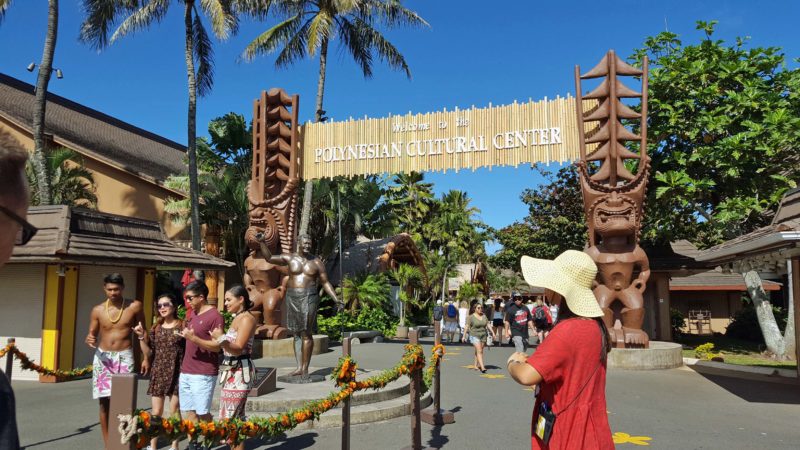
We’re ready to begin our guided walk through the PCC.
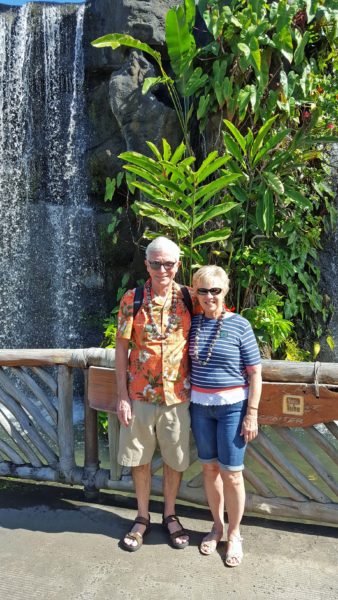
We each received a lei when we entered the PCC. I think they’re made of kukui nuts.
There are six island nations in Polynesia, so the PCC is divided into six villages with each village featuring one nation: Hawai’i, Tonga, Tahiti, New Zealand (Aotearoa), Fiji, and Samoa. Each nation has a representative color, but I don’t remember which is which except that Hawai’i is blue.
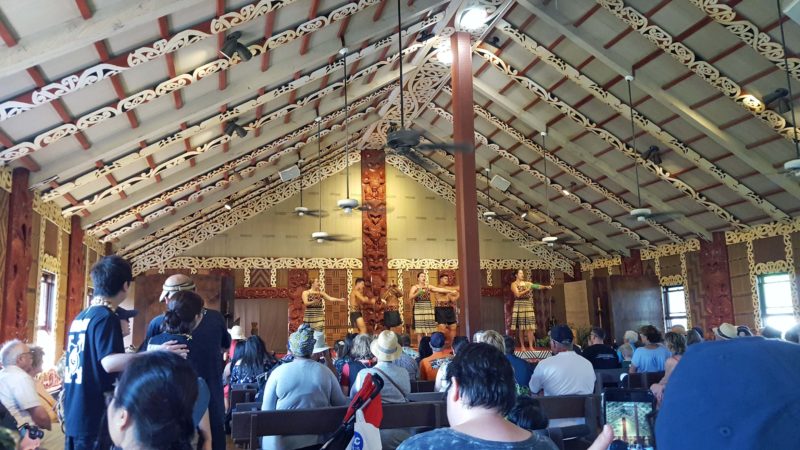
This building is part of the New Zealand (Aotearoa) village. There was a speaker to tell us about NZ, followed by a dancing performance.
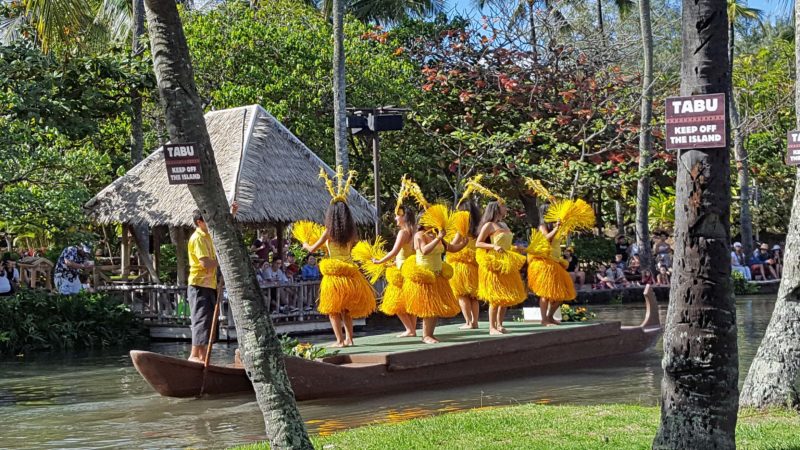
In the Parade of Colors, members of each nation perform a native dance on a platform canoe.
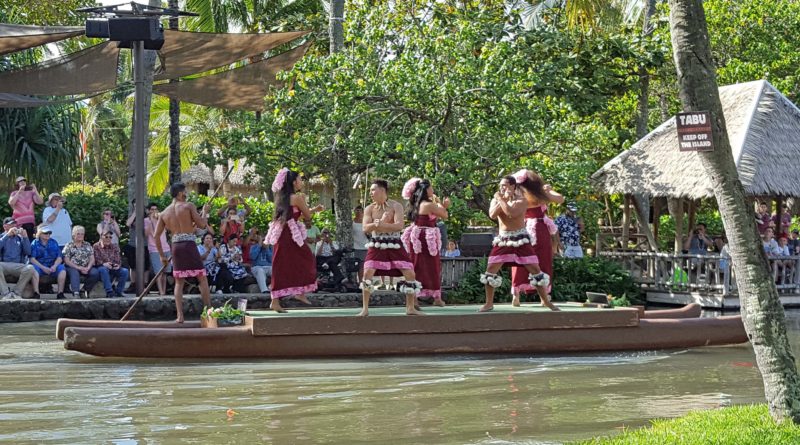
The dances of each nation are similar, but individually distinctive.
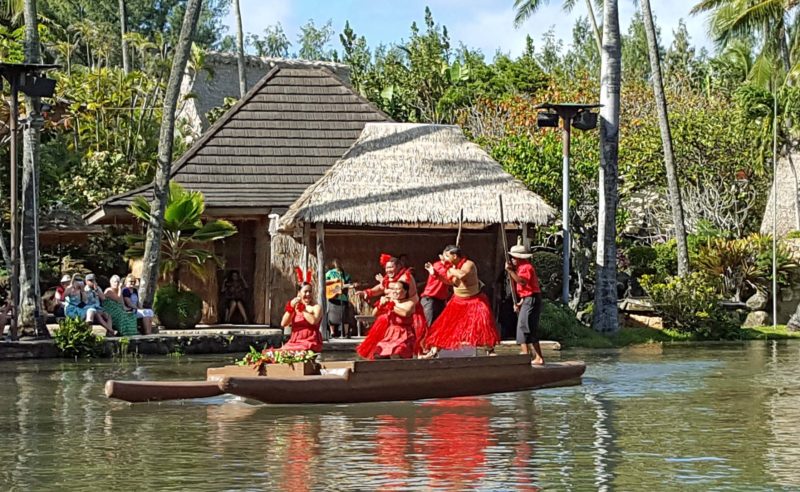
The canoe goes under a bridge when it enters/leaves the lagoon, so the dancers have to finish their performance in time to duck.
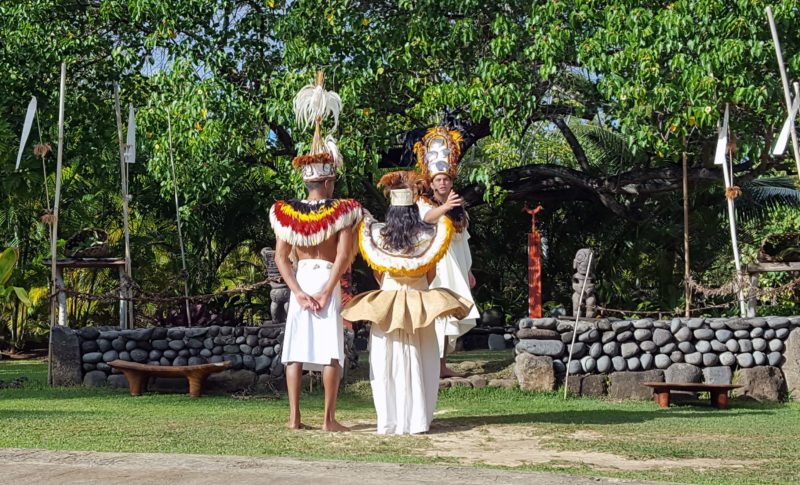
This might have been the Tonga village. We witnessed a (fake) wedding ceremony.
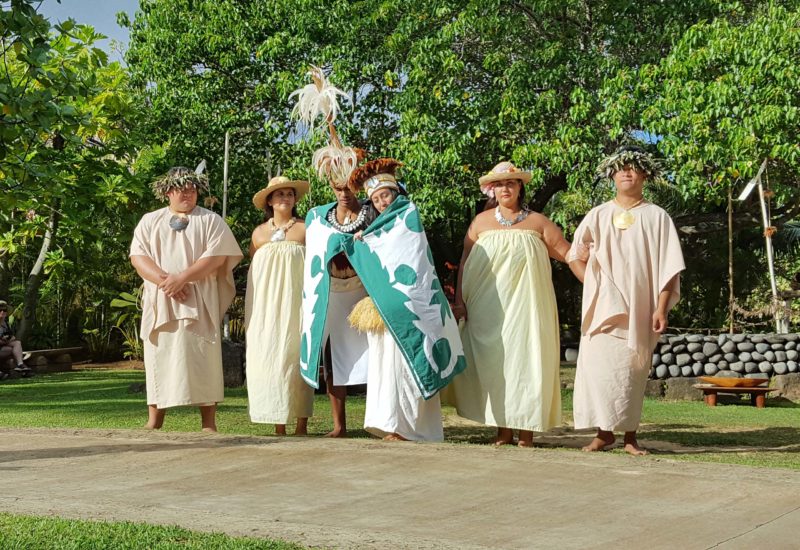
At the close of the ceremony, the bride and groom are draped in a single wedding cloak to symbolize that they are now one.
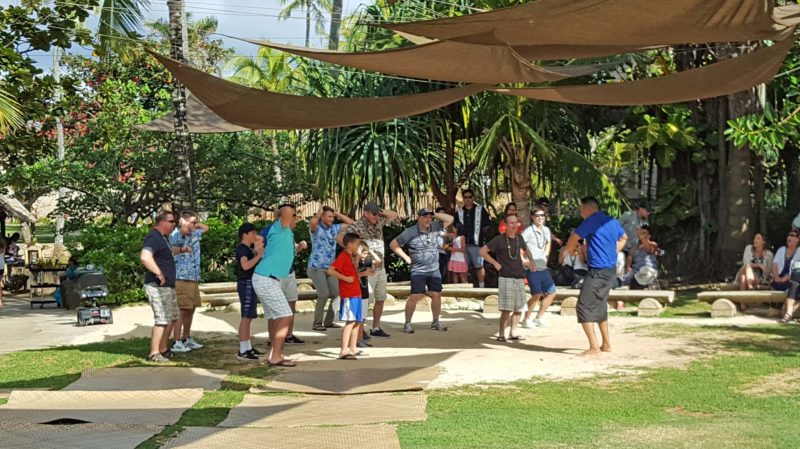
There were cultural lessons at each village, including hula lessons and warrior dance lessons.
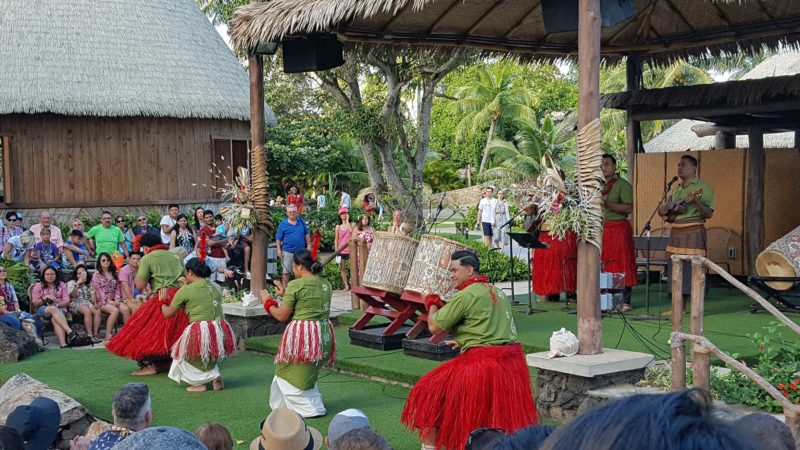
The warrior dances and the drumming were spectacular at this village. Three men from the audience were chosen to participate and they were good enough at repartee and mimicking the performers to try out for the show.
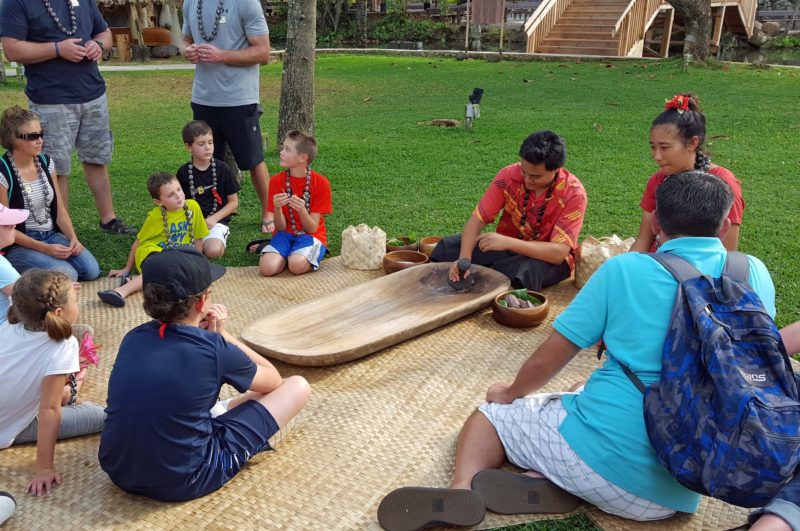
Poi is made from the taro plant. Taro is a purple root plant that is crushed to make a bland, but extremely healthy paste. Poi contains no allergens, it’s safe to feed it to two-week-old babies, and it’s also good for the elderly or sick who cannot digest more complex foods. It doesn’t spoil, but it becomes more acidic as it ages. Its nutrients are believed to be one reason for the beautiful Hawaiian complexions.
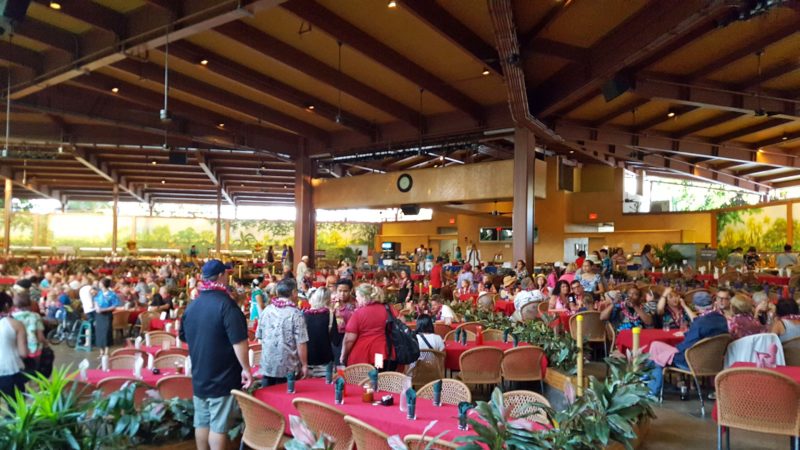
The luau was in another open-sided building. I love this climate!
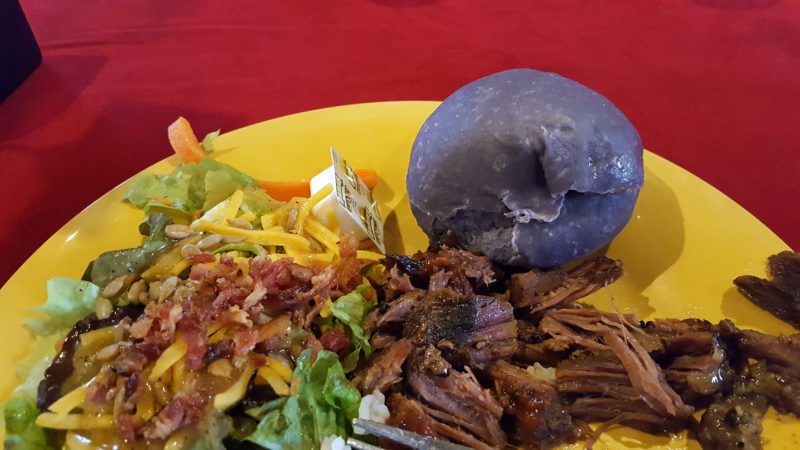
That purple thing on my plate is a poi dinner roll. It was delicious, but Ted decided to pass on purple food.
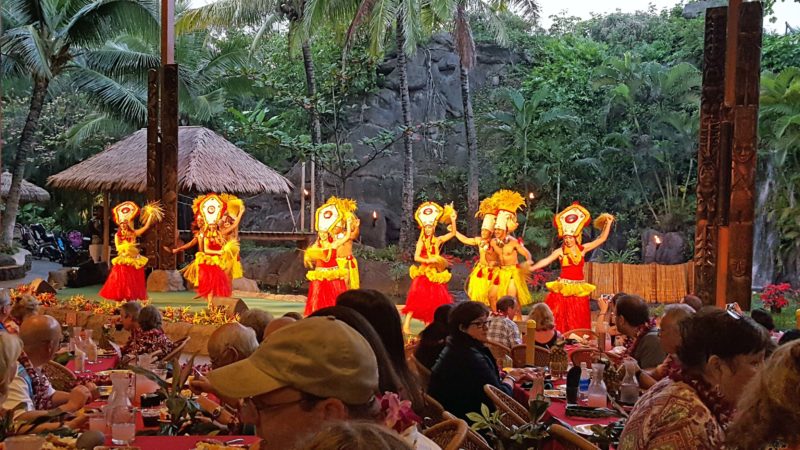
There were more cultural dances during dinner . . .
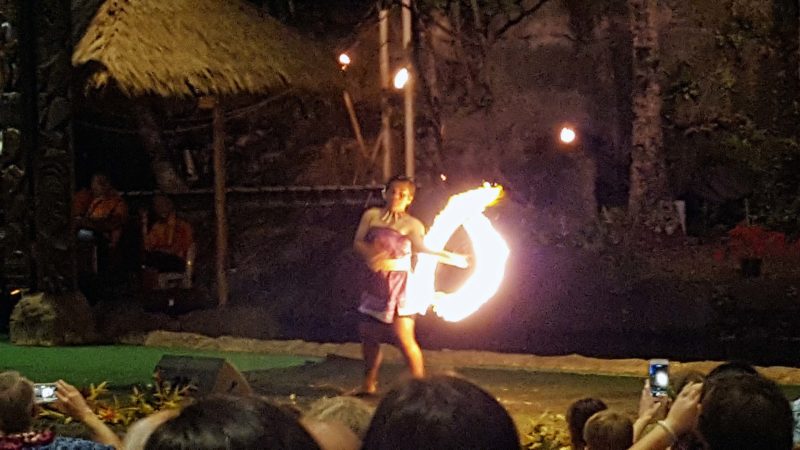
. . . including a fire dancer.
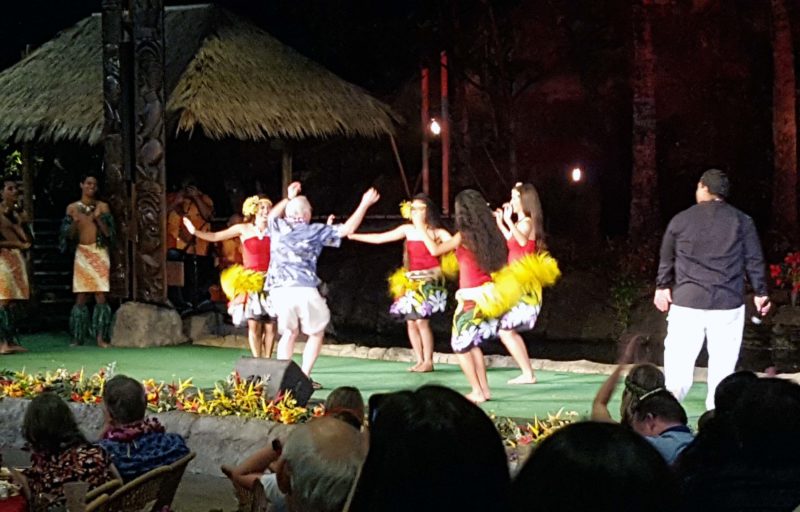
Honeymooners and those celebrating anniversaries were invited to come onstage and dance. The guy in the blue shirt was picked as the best dancer. When the MC asked his spouse if the man was a good dancer, she replied, “Oh, yeah!” He had a lot of endurance and did a decent imitation of a hula too.
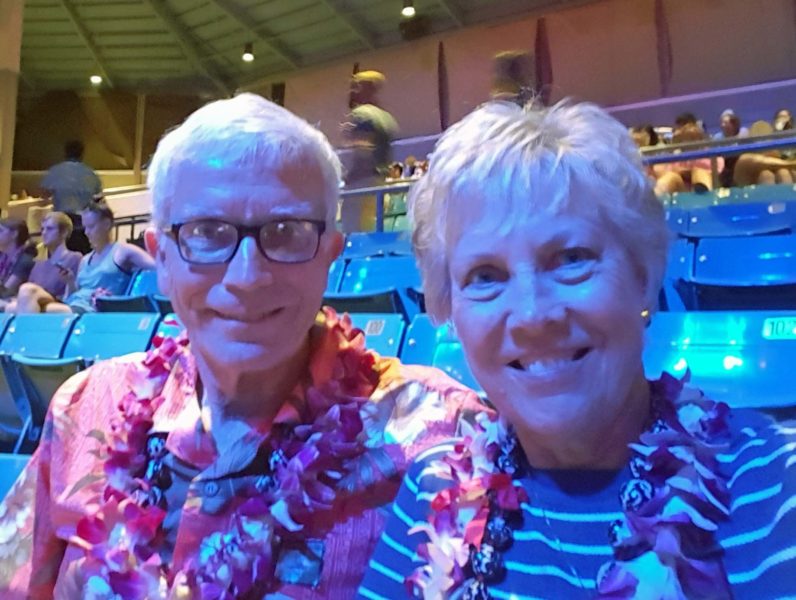
We got a flower lei at the luau. Now we’re ready for the evening show.
The evening performance is called Ha: Breath of Life and was excellent. It began with the birth of a child, then progressed through the stages of the child’s life: learning to hunt from his father, becoming a man, choosing a wife, and having a child of his own. The ending affirmed the theme of Ohana Falls–life is an endless cycle of birth and death. It was very moving and uplifting.
